OCTOBER 2024
FLY AGARIC
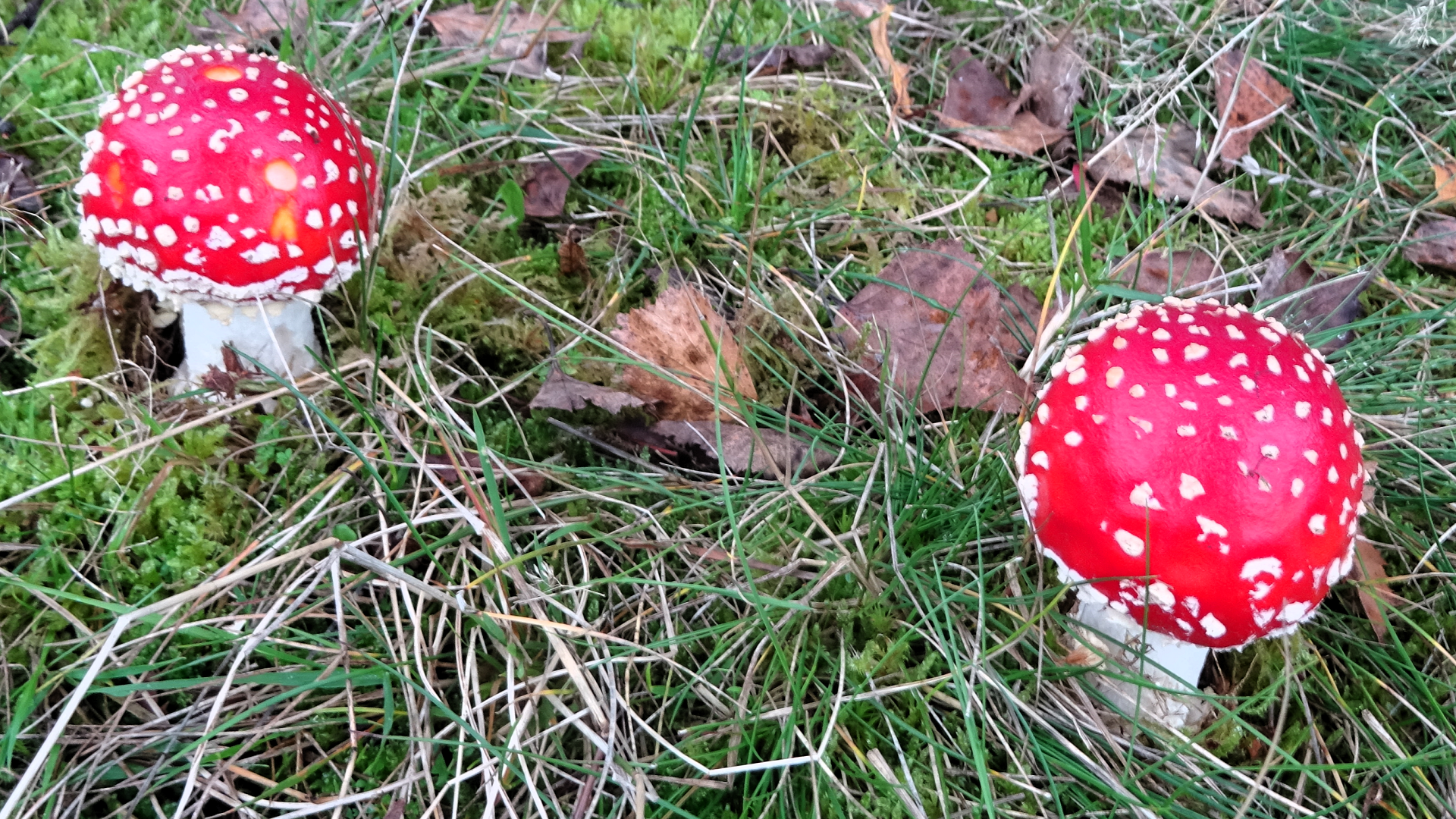
© Raymond Small TQ4792 01/10/2024
Amanita muscaria
The Fly Agaric mushroom is associated with silver birch roots which radiate from the tree. There is a beneficial relationship between the fungal threads (mycorrhiza) and tree roots called symbiosis. The fungi provide the tree roots with water, essential nutrients and chemicals. The tree supplies carbohydrates to the fungi, which, lacking chlorophyll cannot make their own sugar.
YELLOW SHIELD
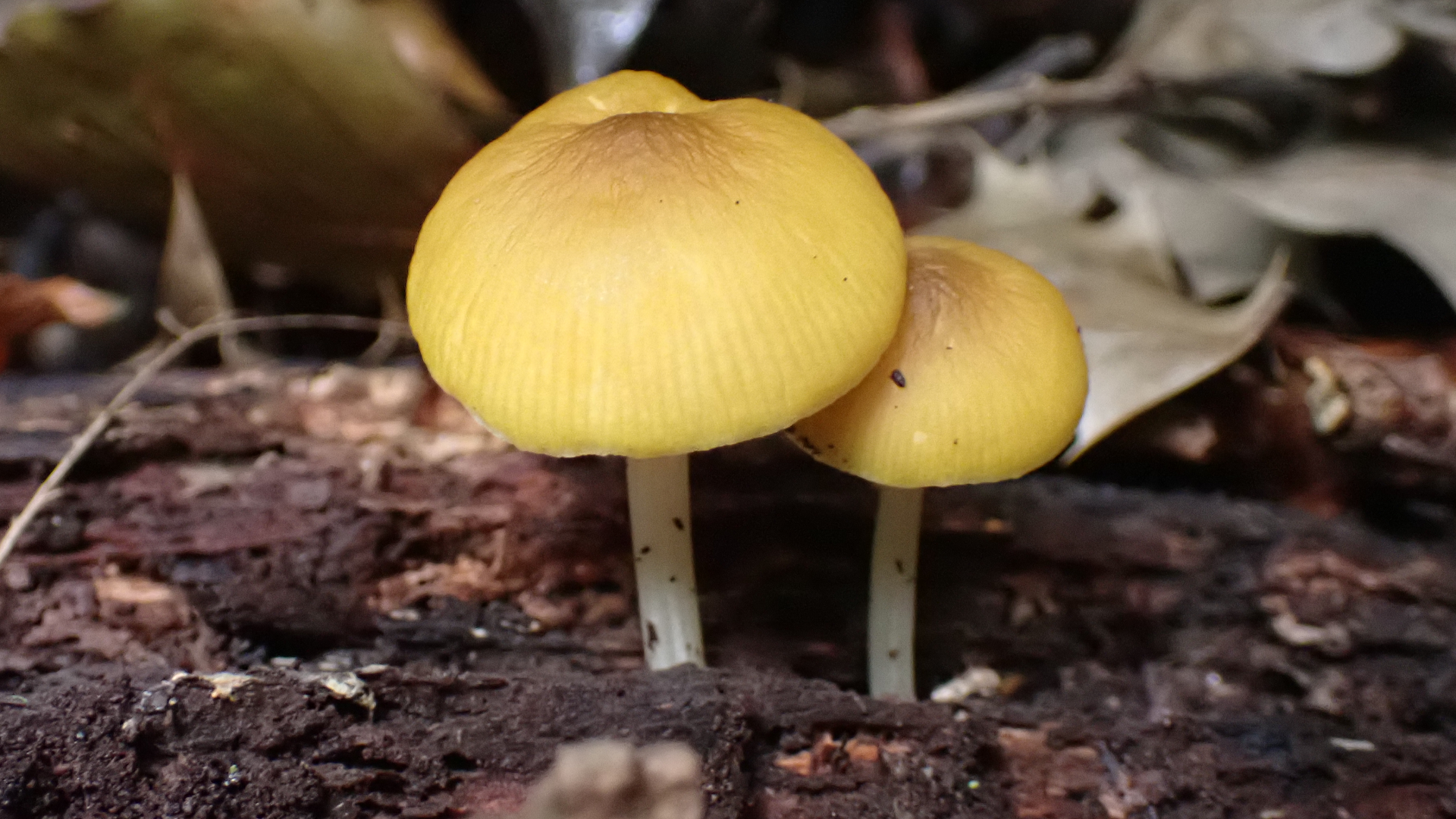
© Raymond Small TQ4792 03/10/2024
Pluteus chrysophaeus
Yellow Shield is a saprobic mushroom that grows on dead beech hardwood. It is usually found solitary or in small groups during late summer and autumn. When the caps flatten they measure 20-40mm across.
DEER SHIELD
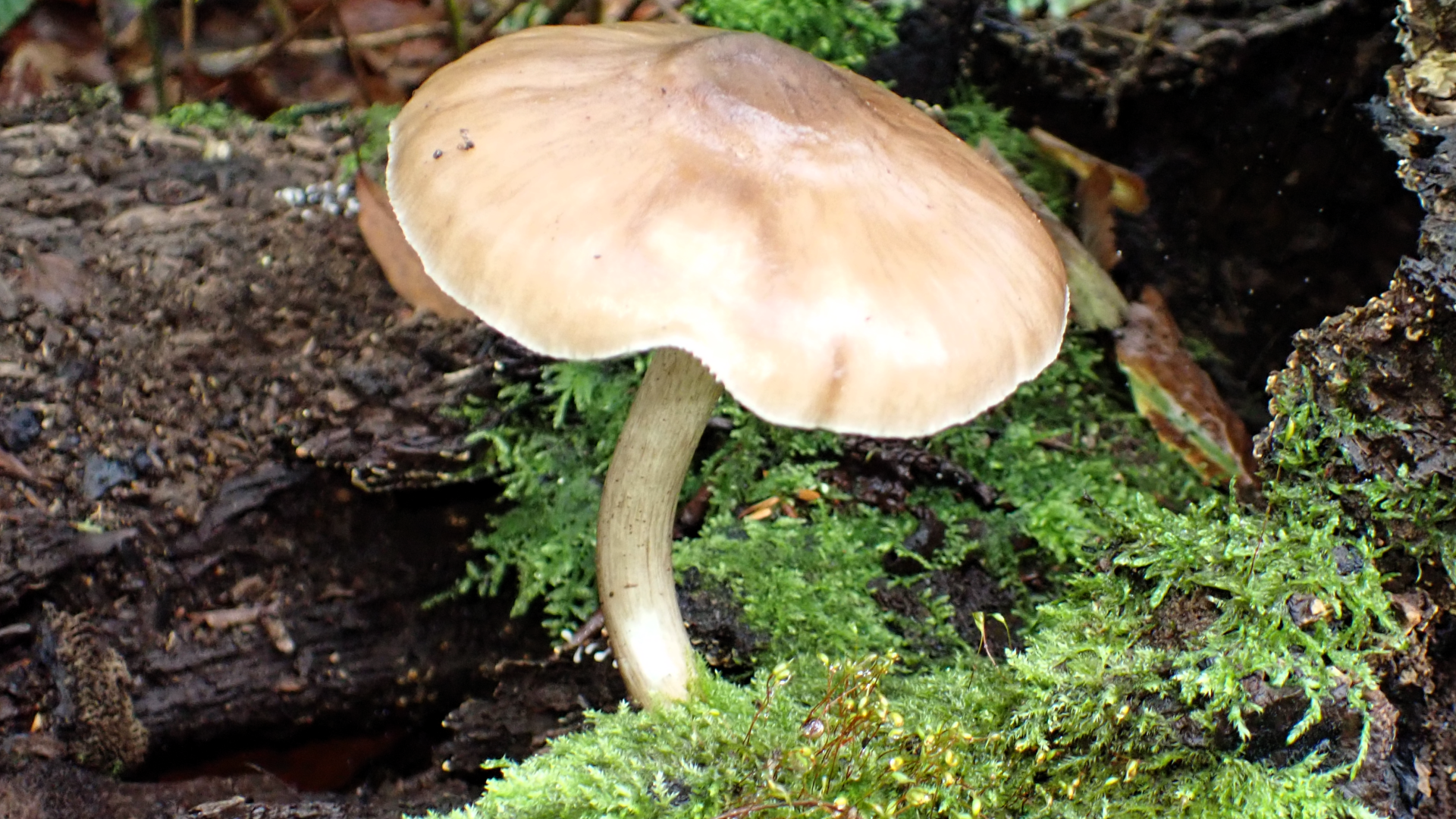
© Raymond Small TQ4793 08/10/2024
Pluteus cervinus
Deer Shield is a wood-rotting fungus that occurs mainly on hardwood stumps either solitary or in small groups.
BURGUNDYDROP BONNET
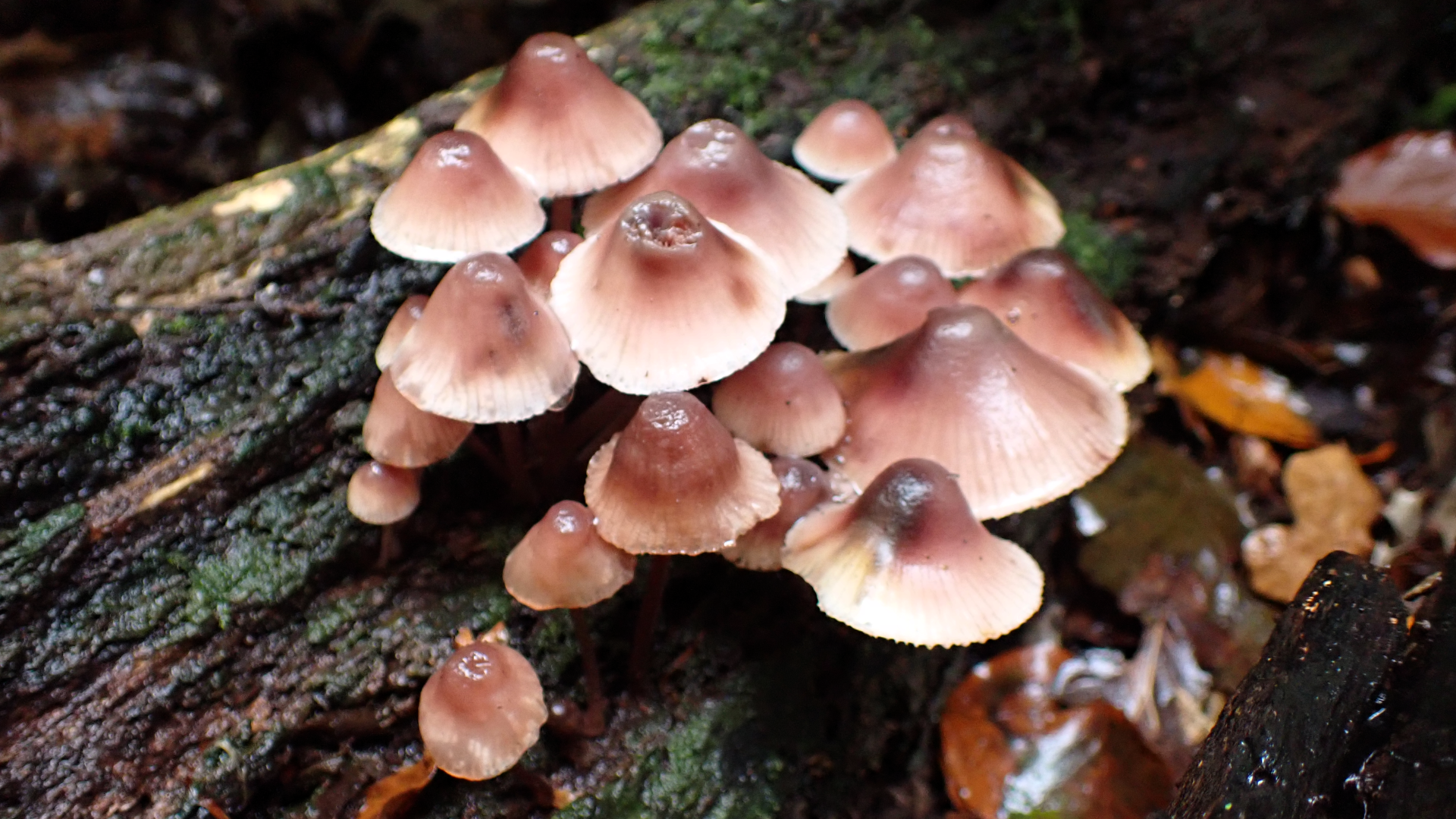
© Raymond Small TQ4792 20/10/2024
Mycena haematopus
This saprobic bonnet mushroom grows on stumps and fallen trunks of deciduous trees (in this case beech) in well-shaded damp locations from June until November. The caps are 20-40mm across when mature.
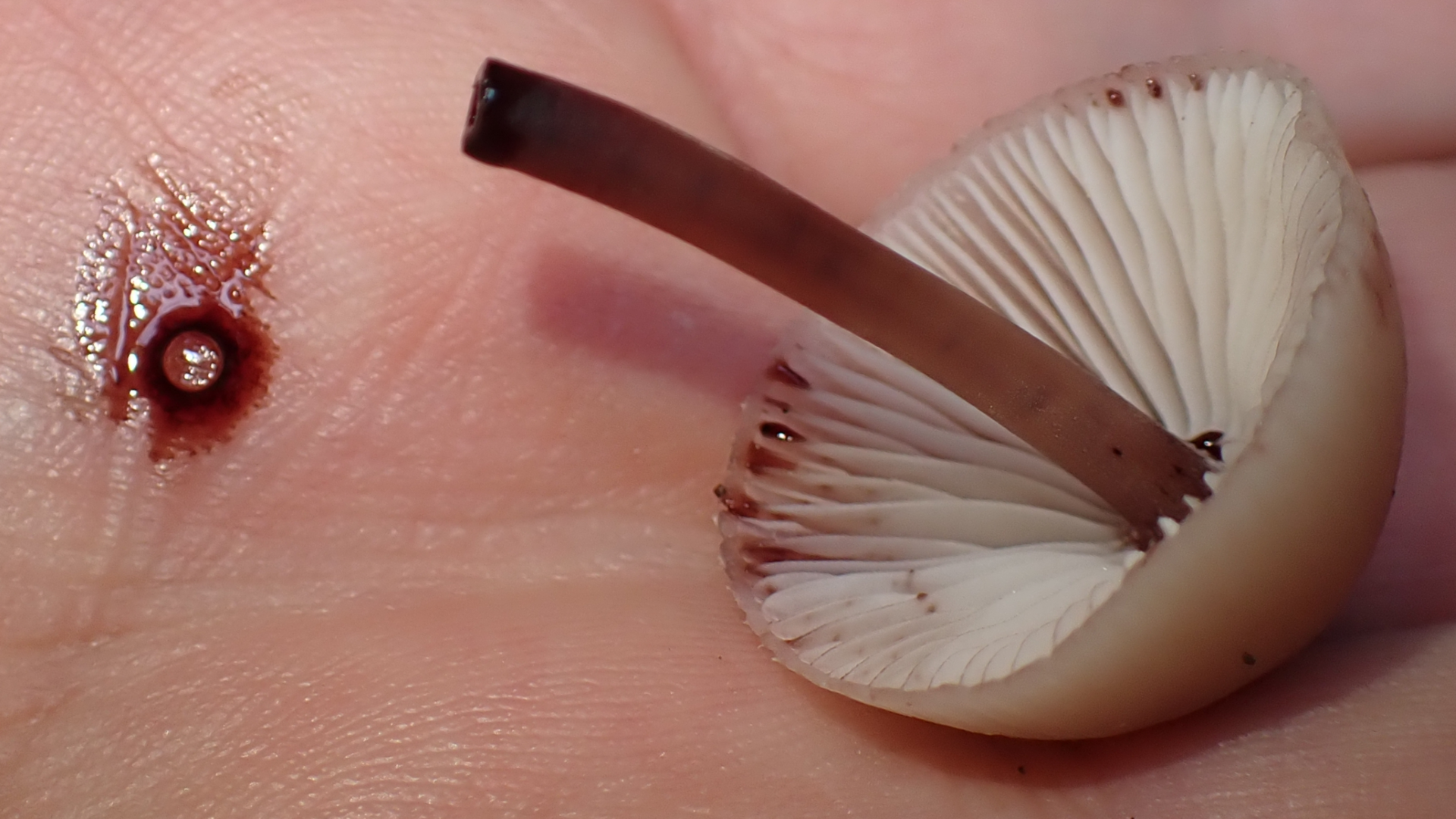
© Raymond Small TQ4792 07/10/2024
Mycena haematopus
When Burgundydrop Bonnet stems are broken a dark red fluid is released.
ANGEL BONNET
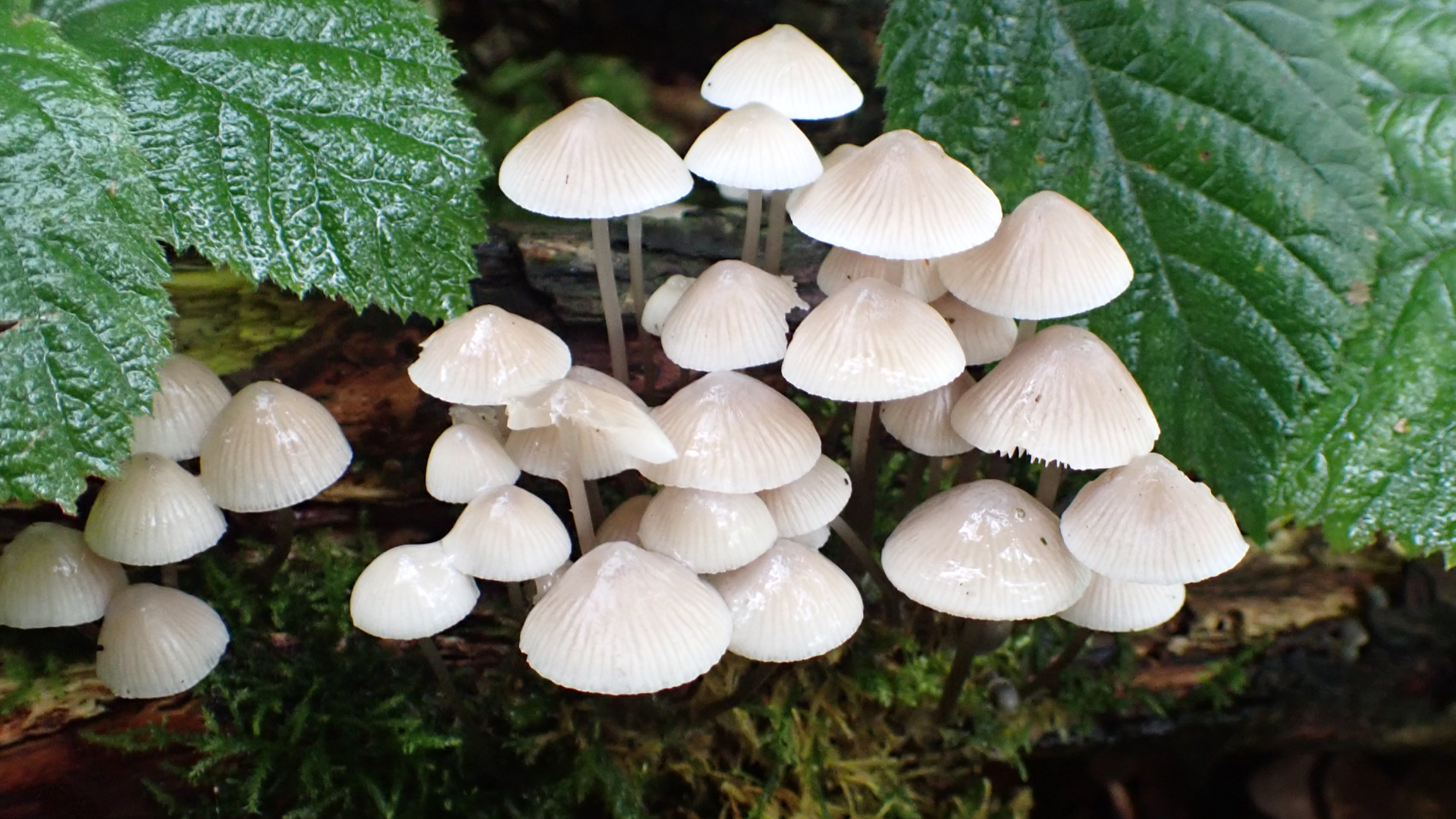
© Raymond Small TQ4793 10/10/2024
Mycena arcangeliana
Angel Bonnets are usually found on stumps and fallen trunks of beech or ash trees, and occasionally other dead hardwoods. The caps measure up to 25mm across. This mushroom smells of iodine.
STEELY BONNETS
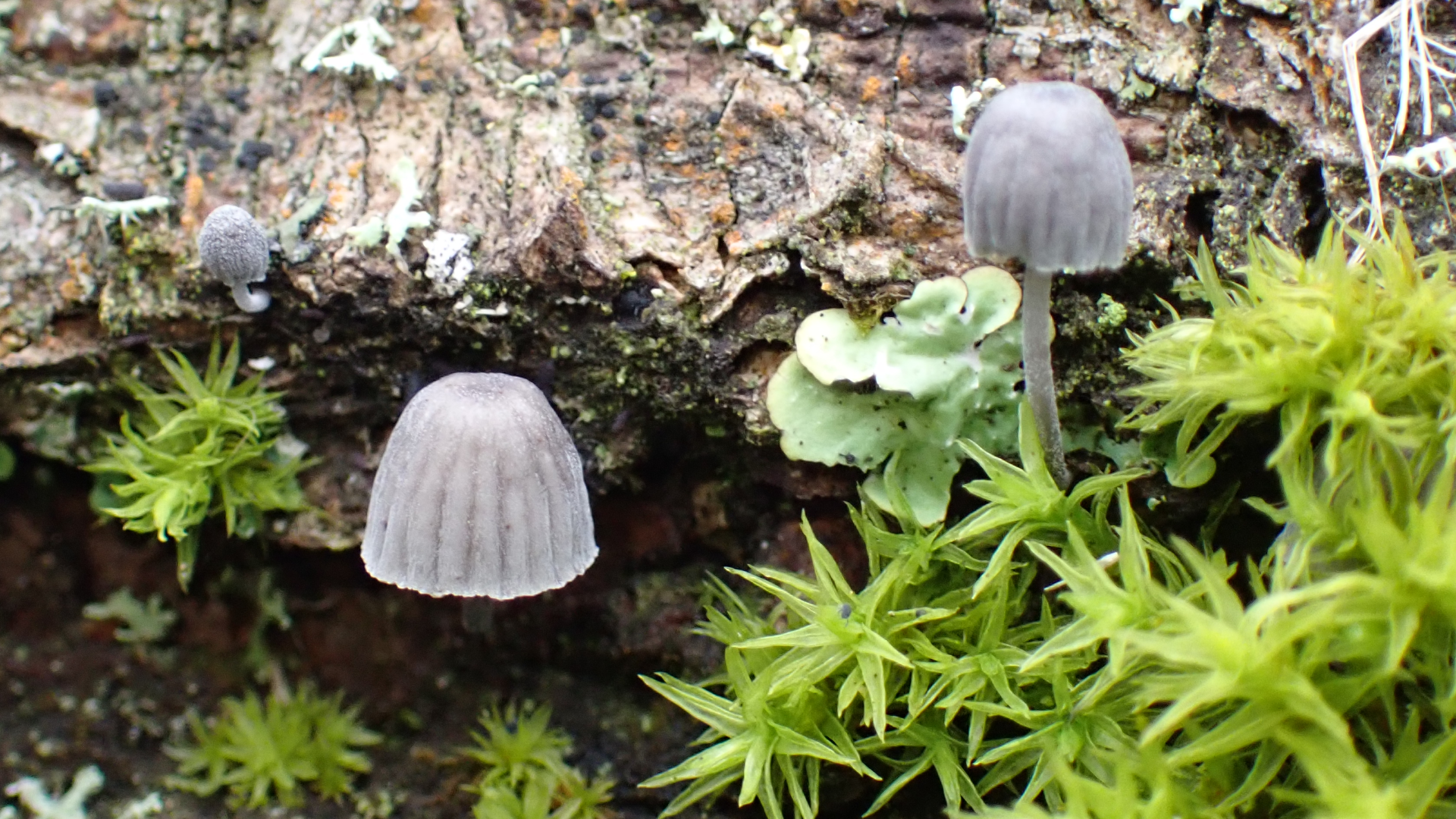
© Raymond Small TQ4792 09/10/2024
Mycena pseudocorticola
This is a tiny saprotrophic species that grows on dead deciduous trees that are usually covered in moss. They are normally seen during autumn and winter.
ROSY BONNET
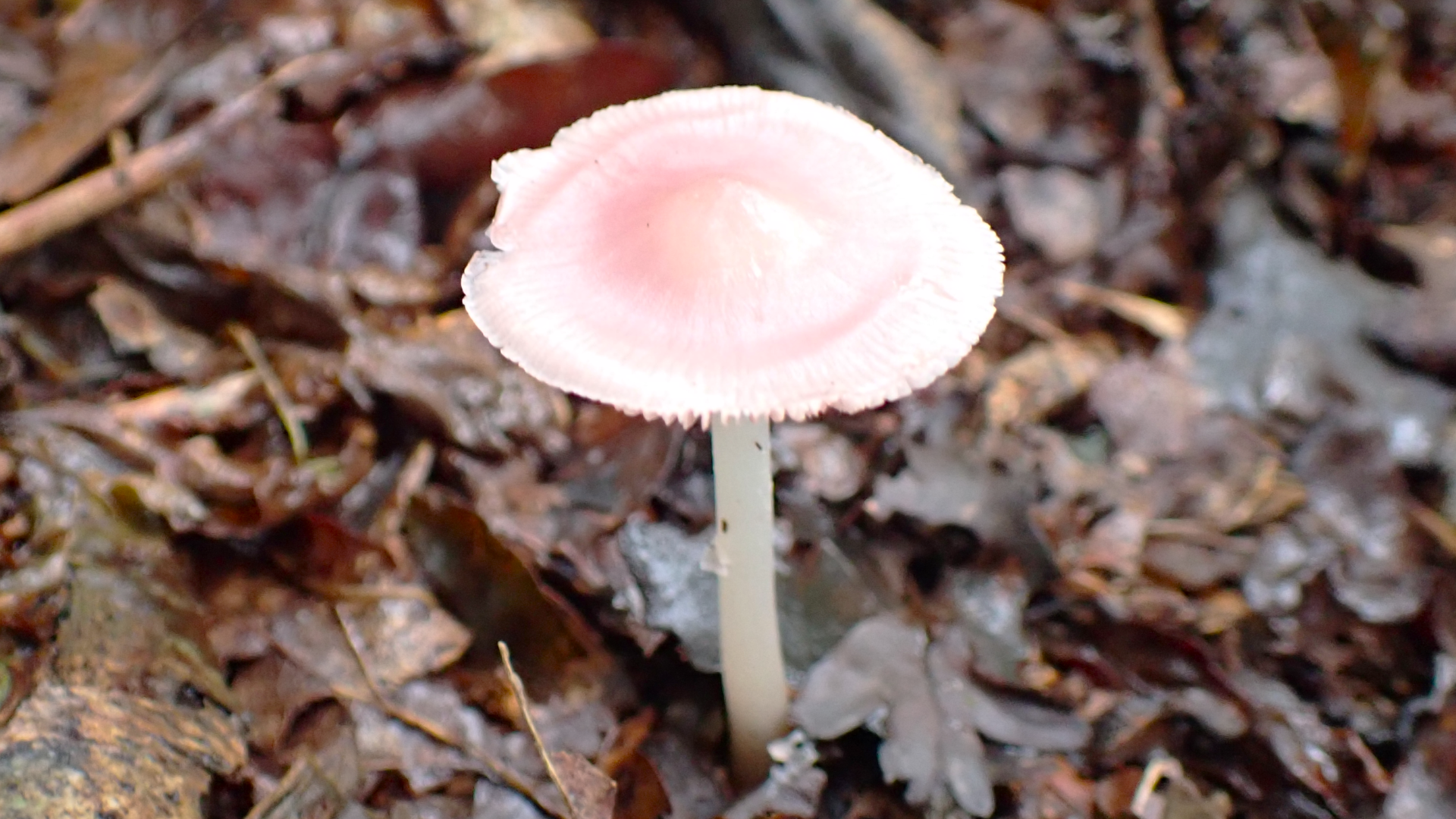
© Raymond Small TQ4793 10/10/2024
Mycena rosea
The Rosy Bonnet is a common woodland species often found in leaf litter. Caps measure up to 60mm in diameter and are pinkish with a whitish margin.
BUTTER CAP
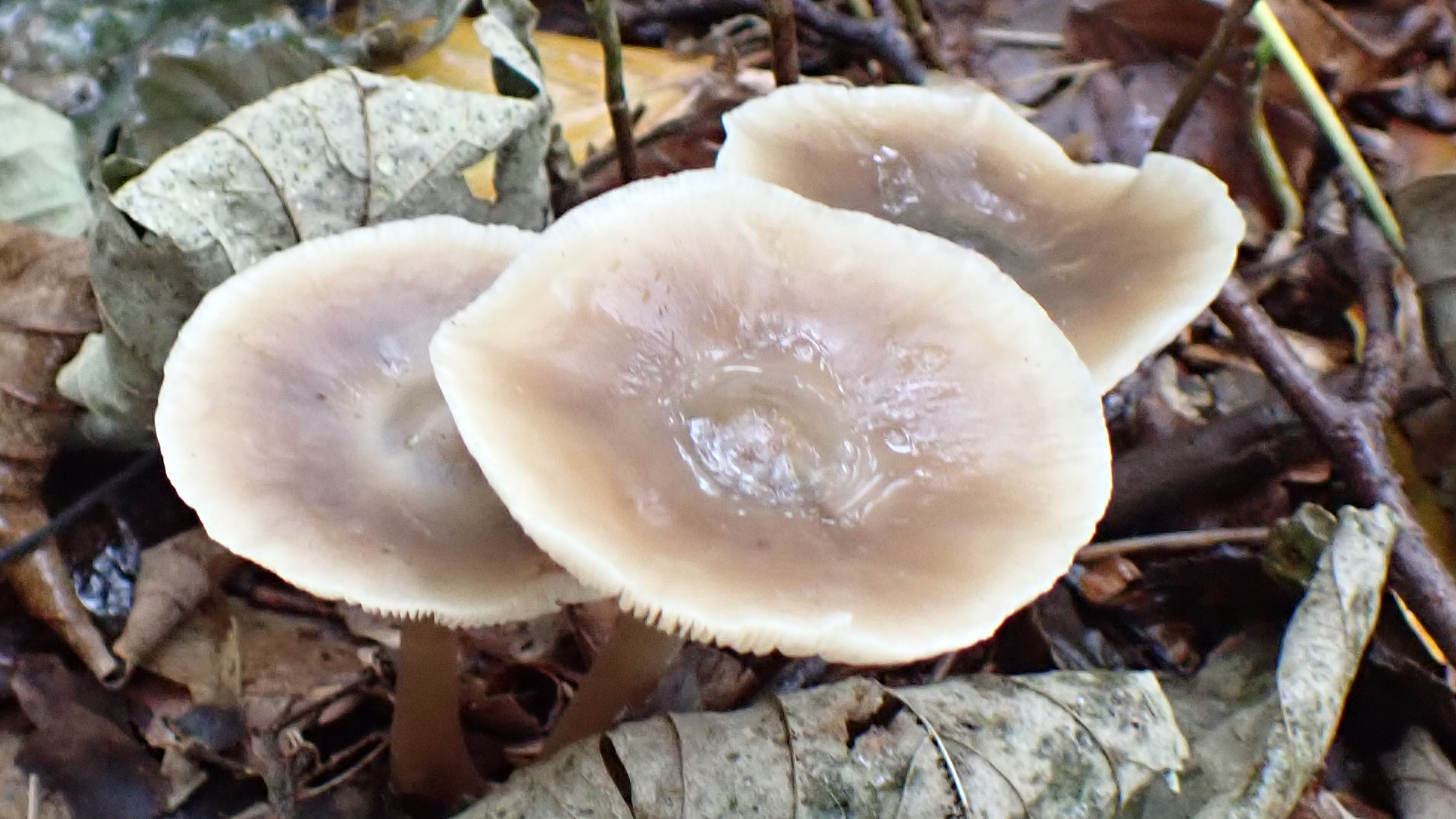
© Raymond Small TQ4792 20/10/2024
Rhodocollybia butyracea
This is a very common woodland fungus that is also known as 'Greasy Toughshank'. It has variable colouration. Sometimes the centre of the cap is dark (var. asema) and sometimes it is light (var. butyracea). These mushrooms are often found in groups or fairy rings.
PARROT WAXCAP
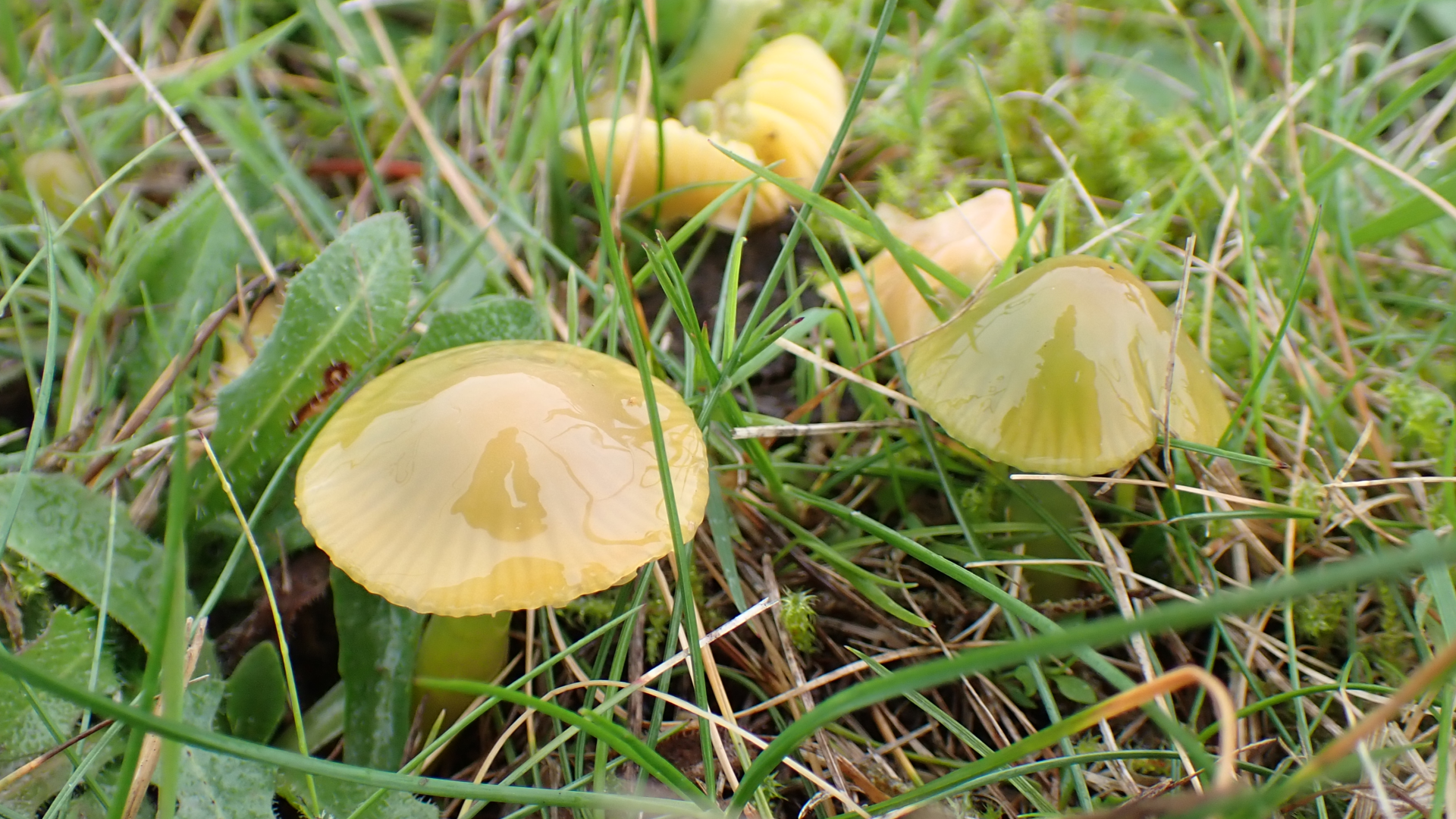
© Raymond Small TQ4792 20/10/2024
Gliophorus psittacinus
The Parrot Waxcap is a familiar grassland fungus often found at Hainault Forest during autumn. The slimy cap, 20-40mm at maturity, goes through colour changes from green to yellow, orange and purple.
FAIRY RING CHAMPIGNON
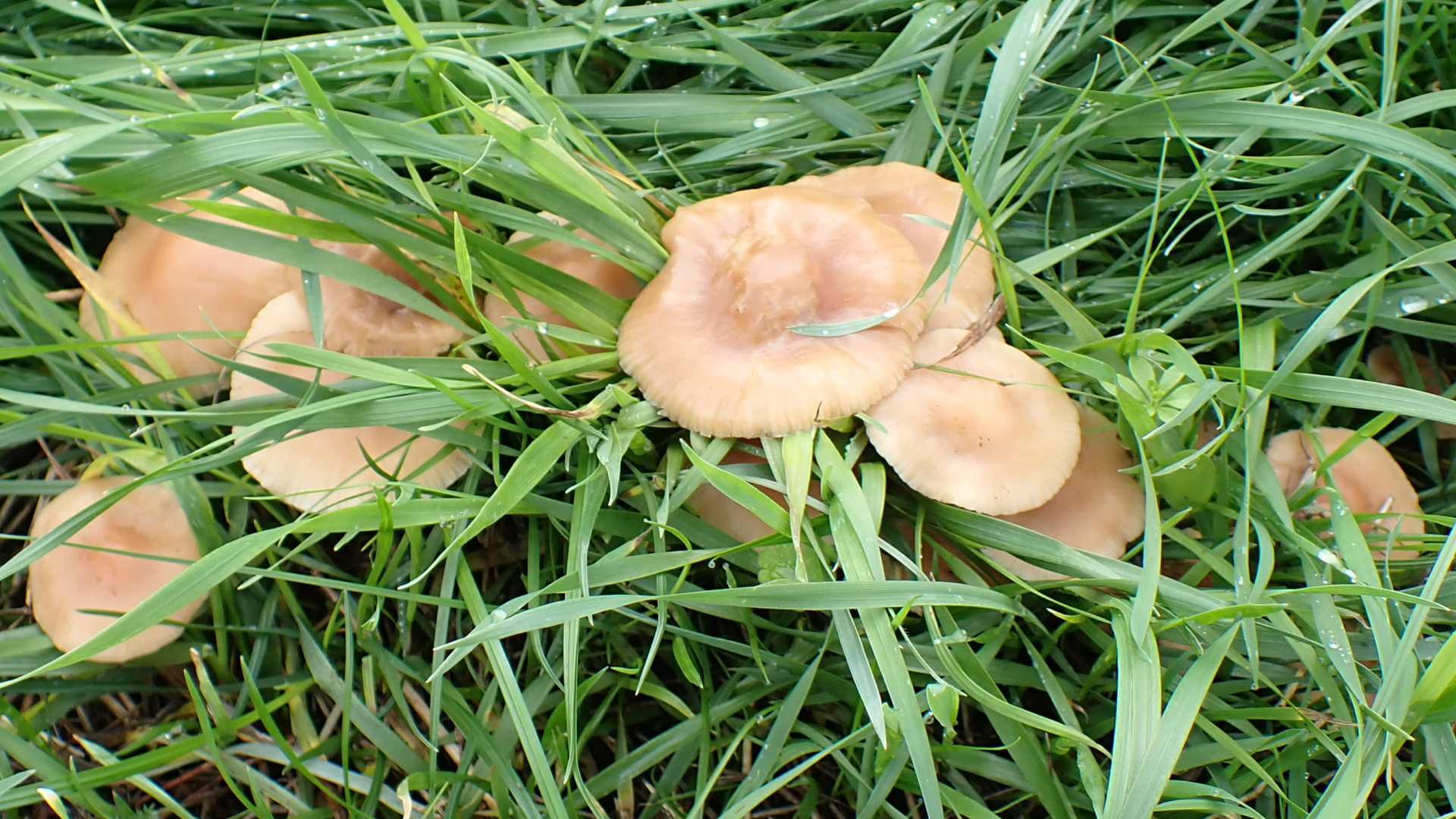
© Raymond Small TQ4692 19/10/2024
Marasmius oreades
A half-ring of Fairy RIng Champignon appeared in the short grass in the middle of the Romford Road dual carriageway. The caps ranged from 20 to 50mm across.
PLEATED INKCAP
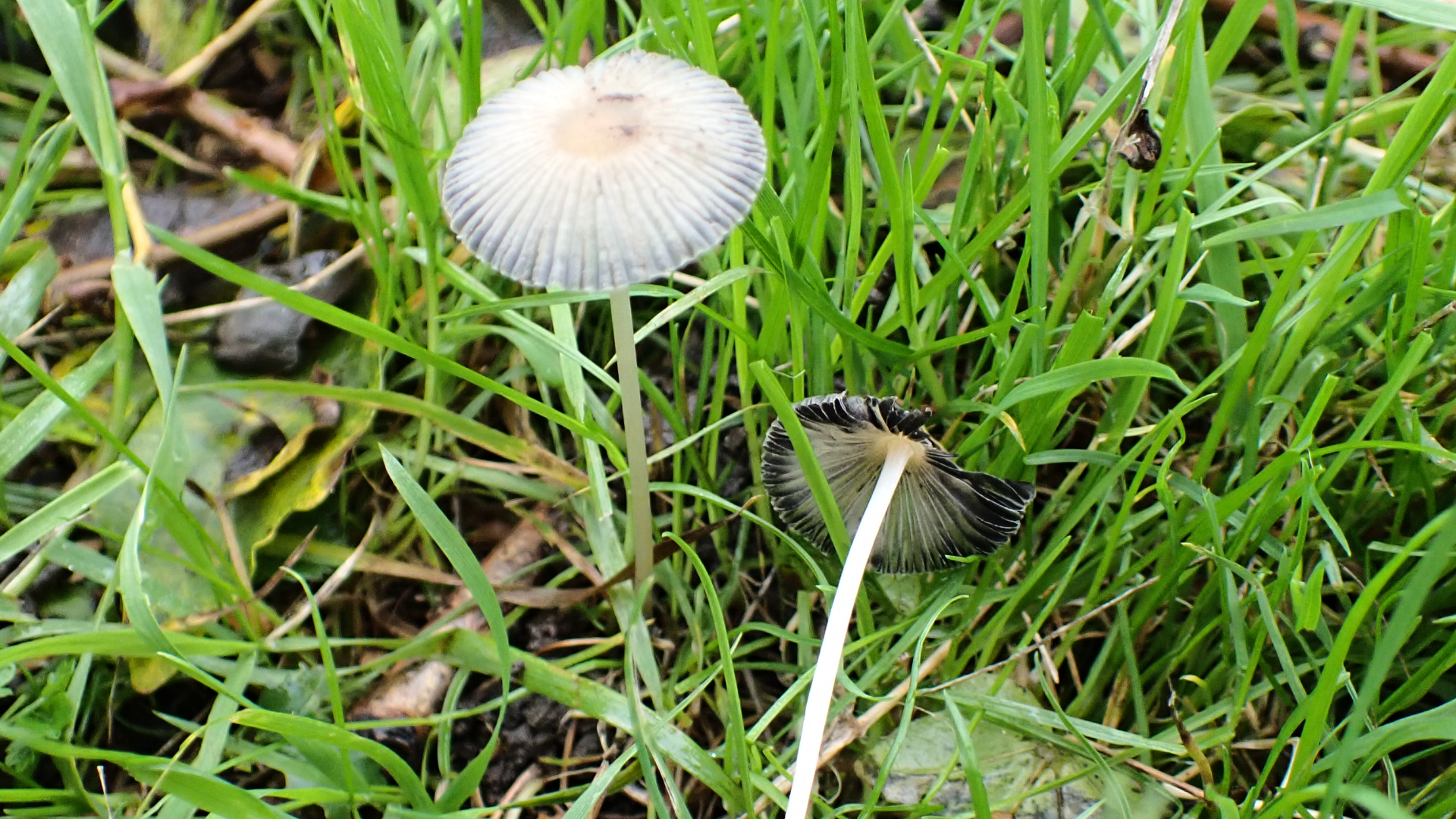
© Raymond Small TQ4692 21/10/2024
Parasola plicatilis
A delicate member of the Inkcap family that often disolves into a black slime within 24 hours. The heavily ribbed cap has a diameter of 10-20mm, is initially egg-shaped, then convex and finally flat.
WHITE SADDLE
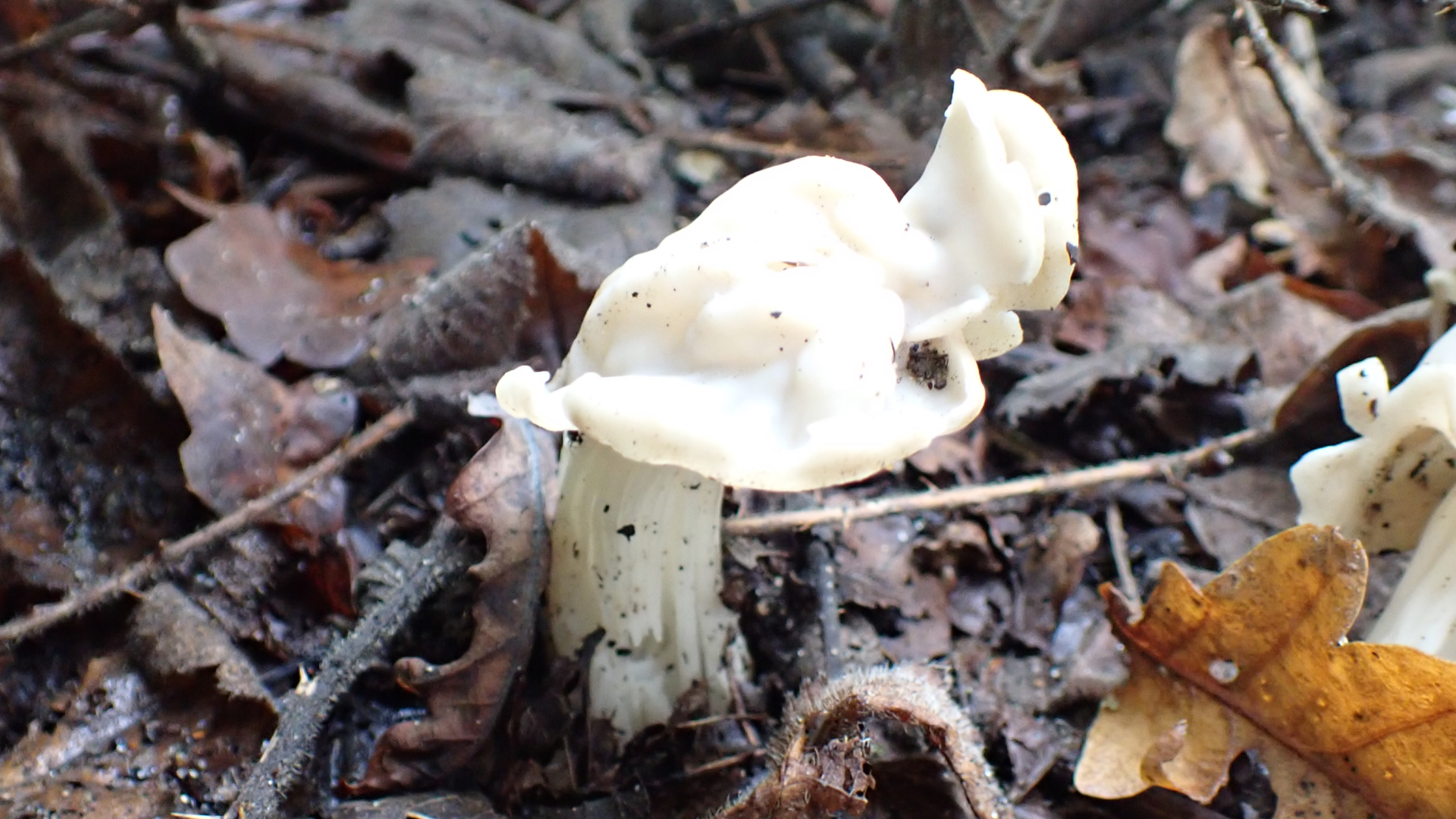
© Raymond Small TQ4793 15/10/2024
Helvella crispa
These mushrooms with saddle-shaped caps are common in the forest. The caps are 30-80mm across, have a smooth upper surface and underneath feels slightly downy. The furrowed stipe tapers upwards and measures 40-80mm in length.
WILLOW BRACKET
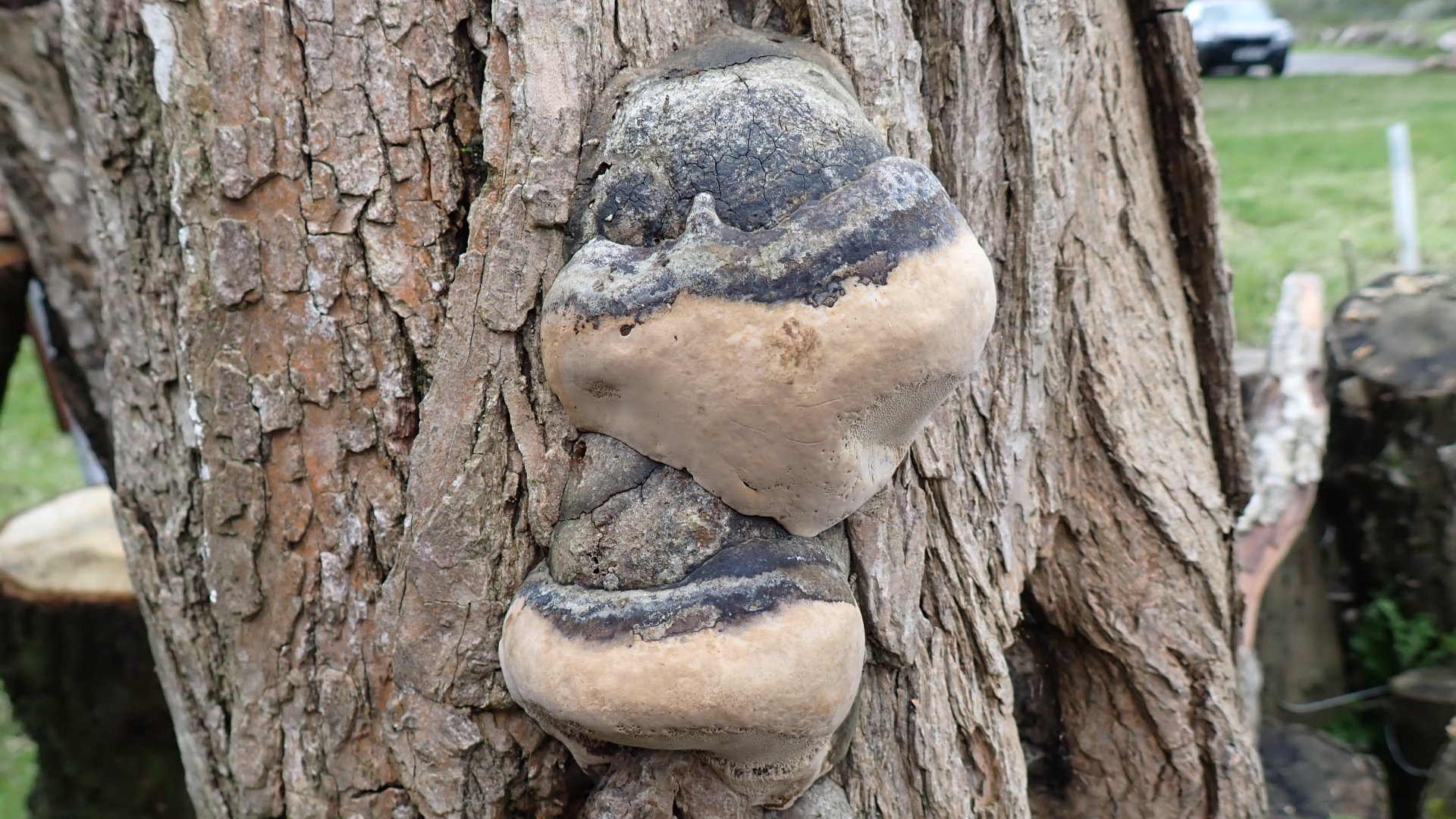
© Raymond Small TQ4792 09/10/2024
Phellinus igniarius
Willow Bracket is a very tough fungus associated with willow trees, seen all year round on lower trunks of older trees. It grows in concentrically ridged layers with a fresh layer forming each year. The new layers are light-brown and feel like velvet. Older layers turn grey, then blacken and often develop cracks.
YELLOW BRAIN FUNGUS
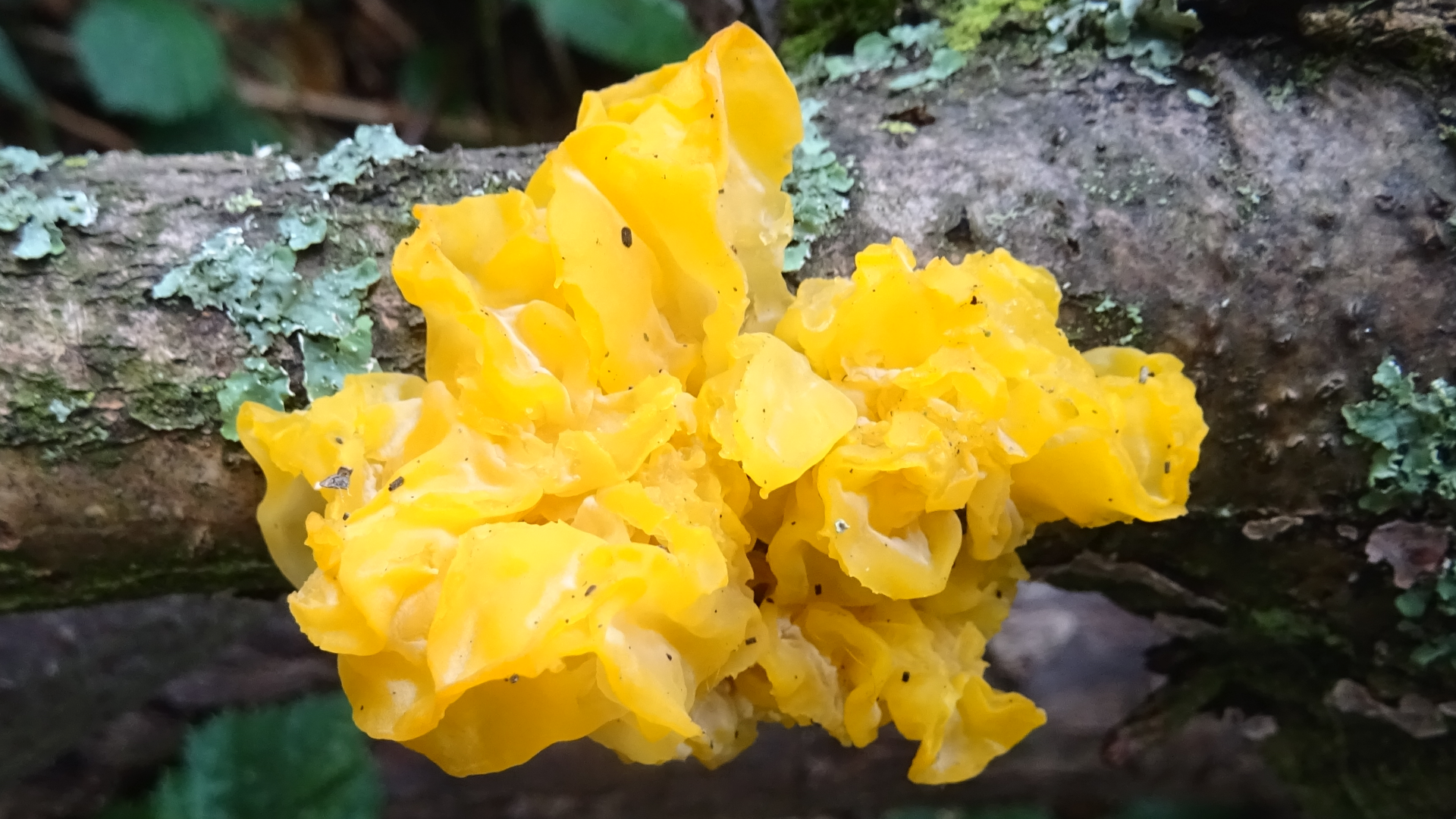
© Raymond Small TQ4792 13/10/2024
Tremella mesenterica
Yellow Brain has a bright yellow fruiting body that mainly appears during autumn and winter on fallen deciduous branches. It turns hard and orange when dried out.
WITCHES' BUTTER
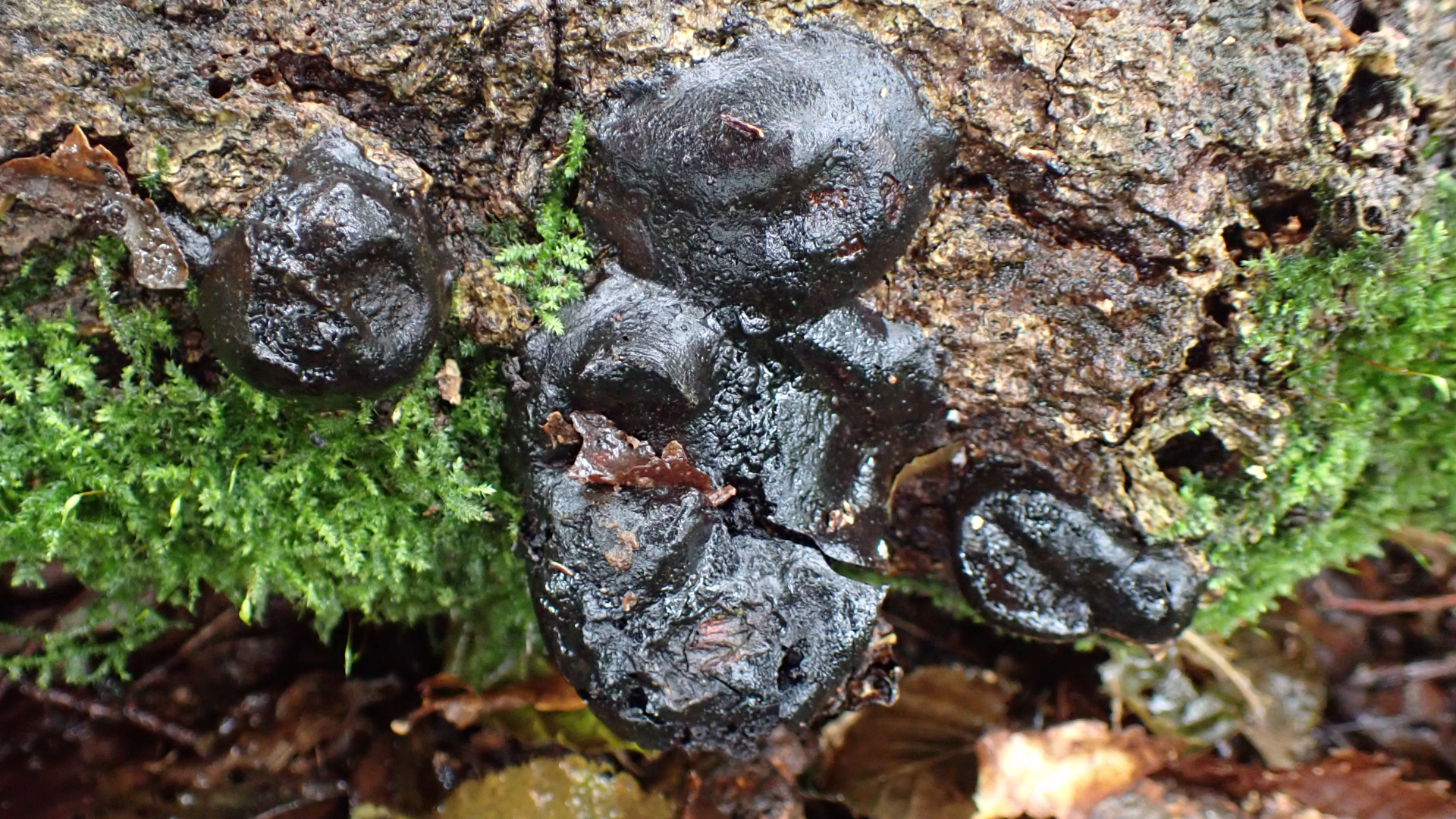
© Raymond Small TQ4792 10/10/2024
Exidia glandulosa
Witches' Butter appears on deciduous dead wood during autumn and winter. The fruiting bodies attach to the wood using tiny stems. More noticeable after prolonged wet weather when they become plump and fleshy.
WHITE BRAIN
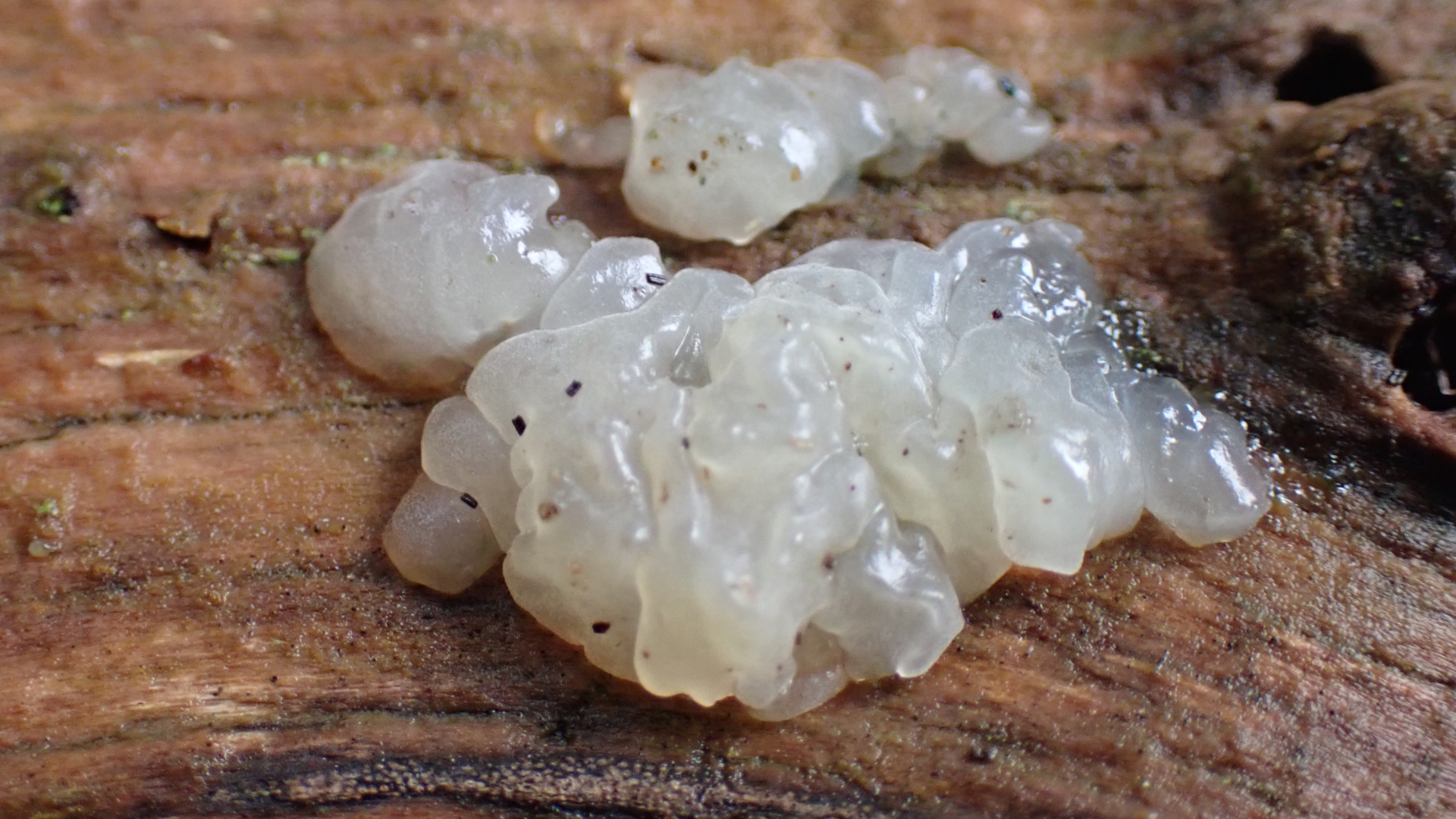
© Raymond Small TQ4792 08/10/2024
Exidia thuretiana
White Brain is found on rotten hardwood, particularly beech, during autumn and winter. In dry weather the fruiting bodies shrink becoming hard and leaving just a transparent rubbery spot on the host wood.
COMMON PUFFBALL
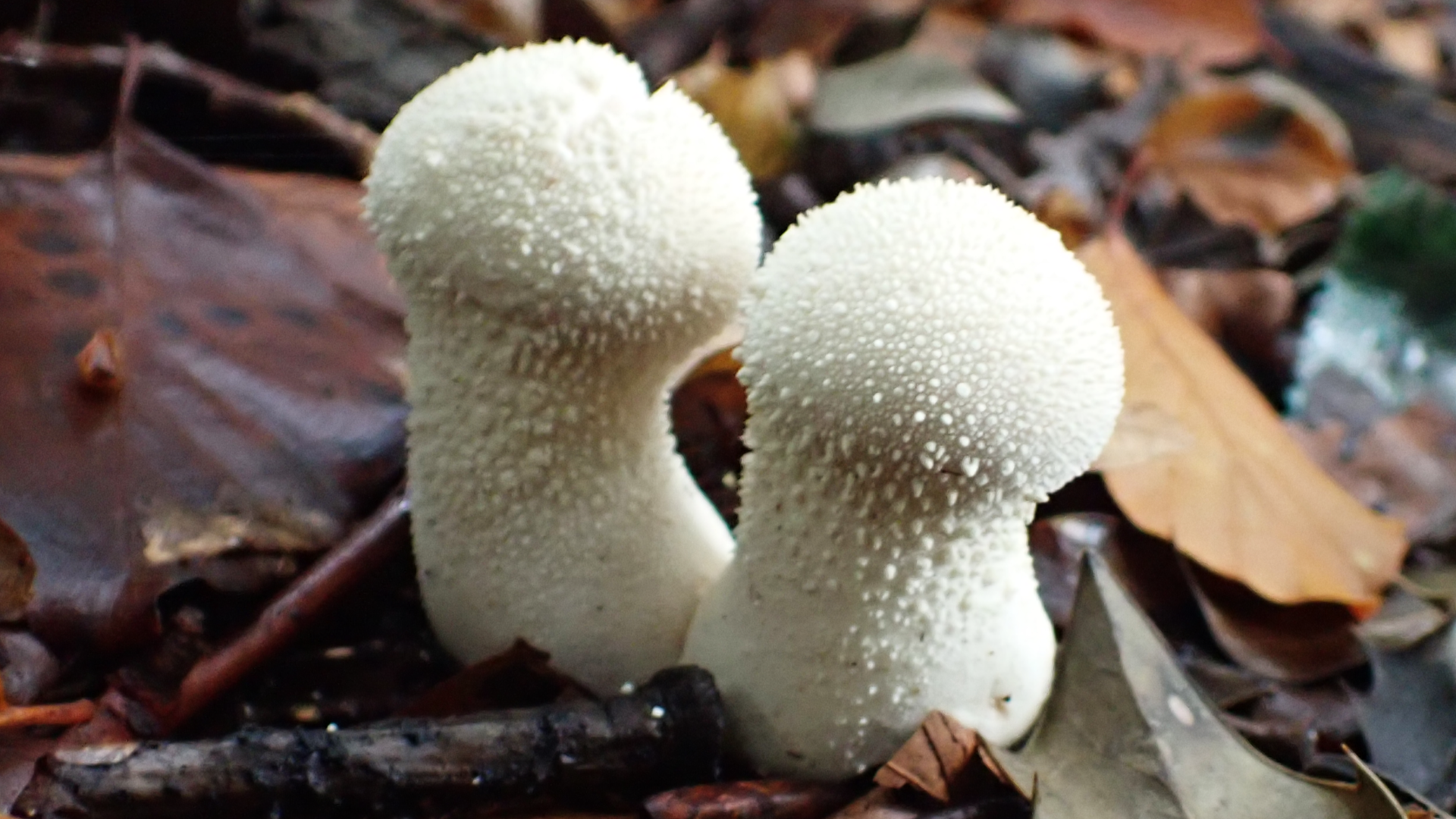
© Raymond Small TQ4793 15/10/2024
Lycoperdon perlatum
Common Puffballs are normally found in small, scattered, groups in leaf litter under trees during summer and autumn, standing 40-80mm tall. Mature specimens release spores through a hole in the top which get dispersed by wind and rain.
STUMP PUFFBALL
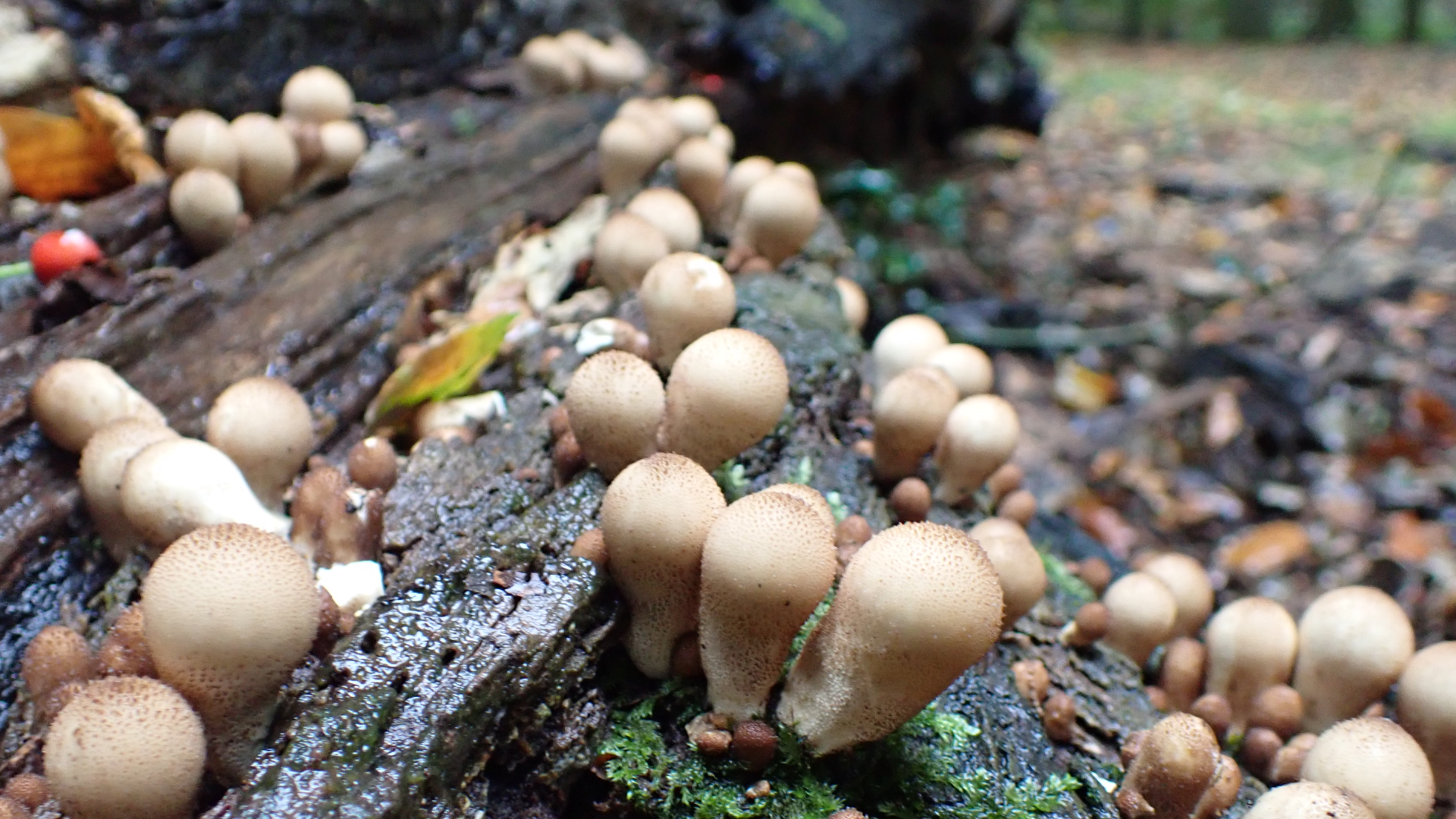
© Raymond Small TQ4792 20/10/2024
Apioperdon pyriforme
Stump Puffballs on a fallen beech trunk on Hog Hill. This is the only puffball that grows on wood. The club-shaped fruiting bodies measured up to 30mm across and 40mm tall.
TROOPING FUNNEL
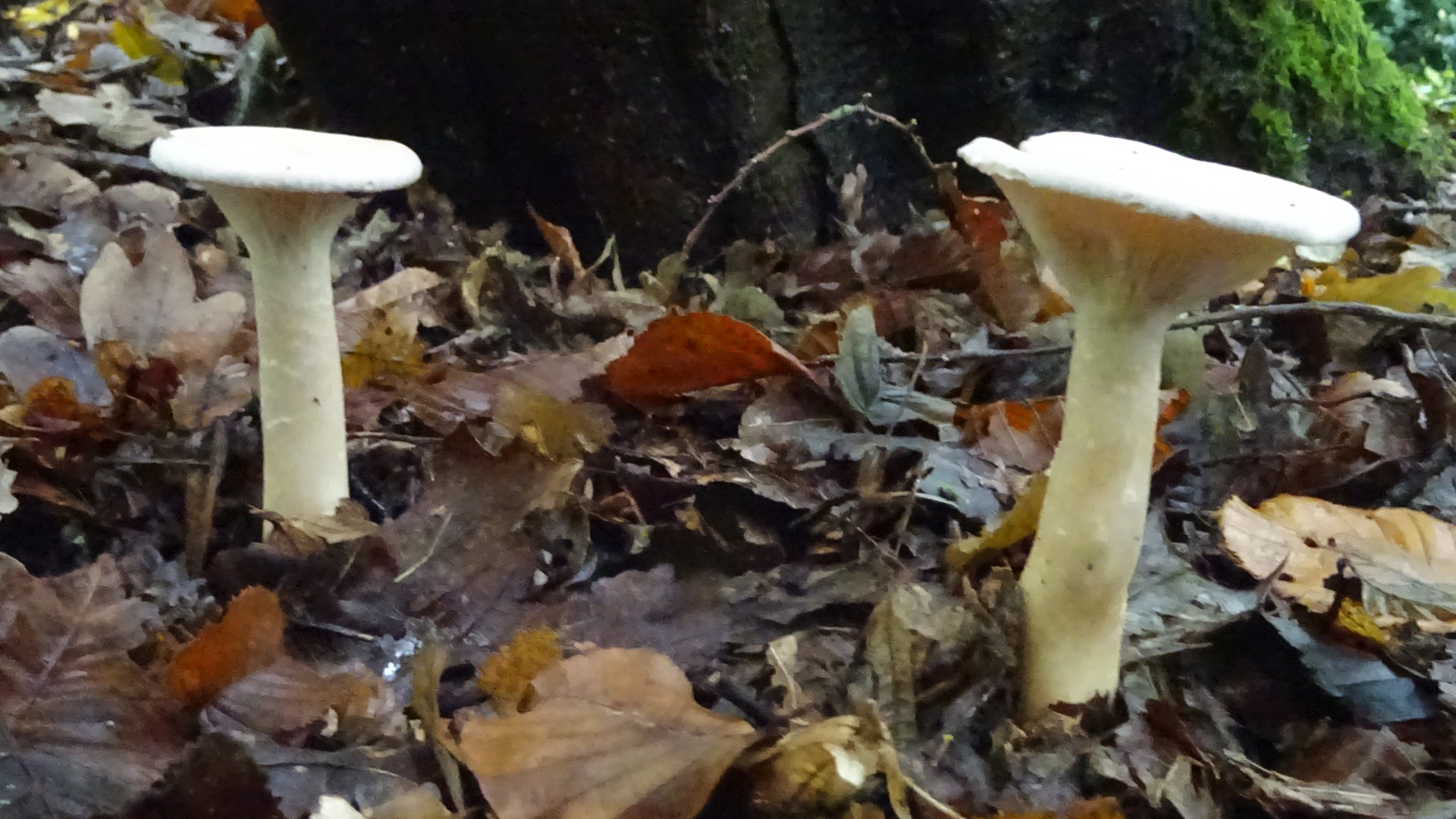
© Raymond Small TQ4793 15/10/2024
Clitocybe geotropa
Trooping Funnels often grow in rings in deciduous woodland, although occasionally solitary mushrooms occur. The creamy-buff caps are typically 10-15cm across when fully grown with a fairly broad central umbo on top.
CANDLESNUFF
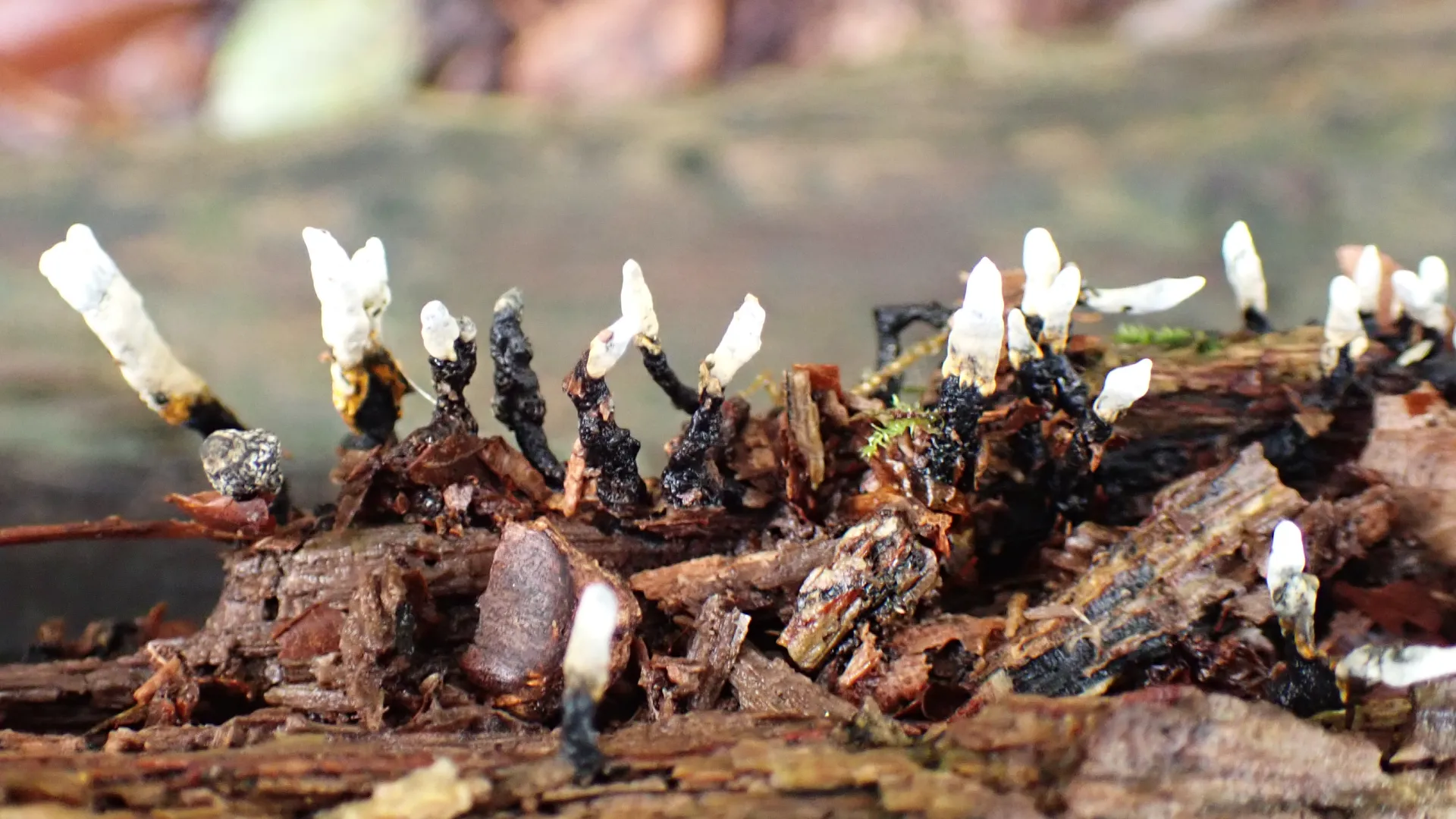
© Raymond Small TQ4792 09/10/2024
Xylaria hypoxylon
Candlesnuff is a very common wood-rotting fungus seen all through the year. It has stick-like or forked fruiting bodies with black bases and white powdery tips. Height 10-60mm.
PORCELAIN FUNGUS
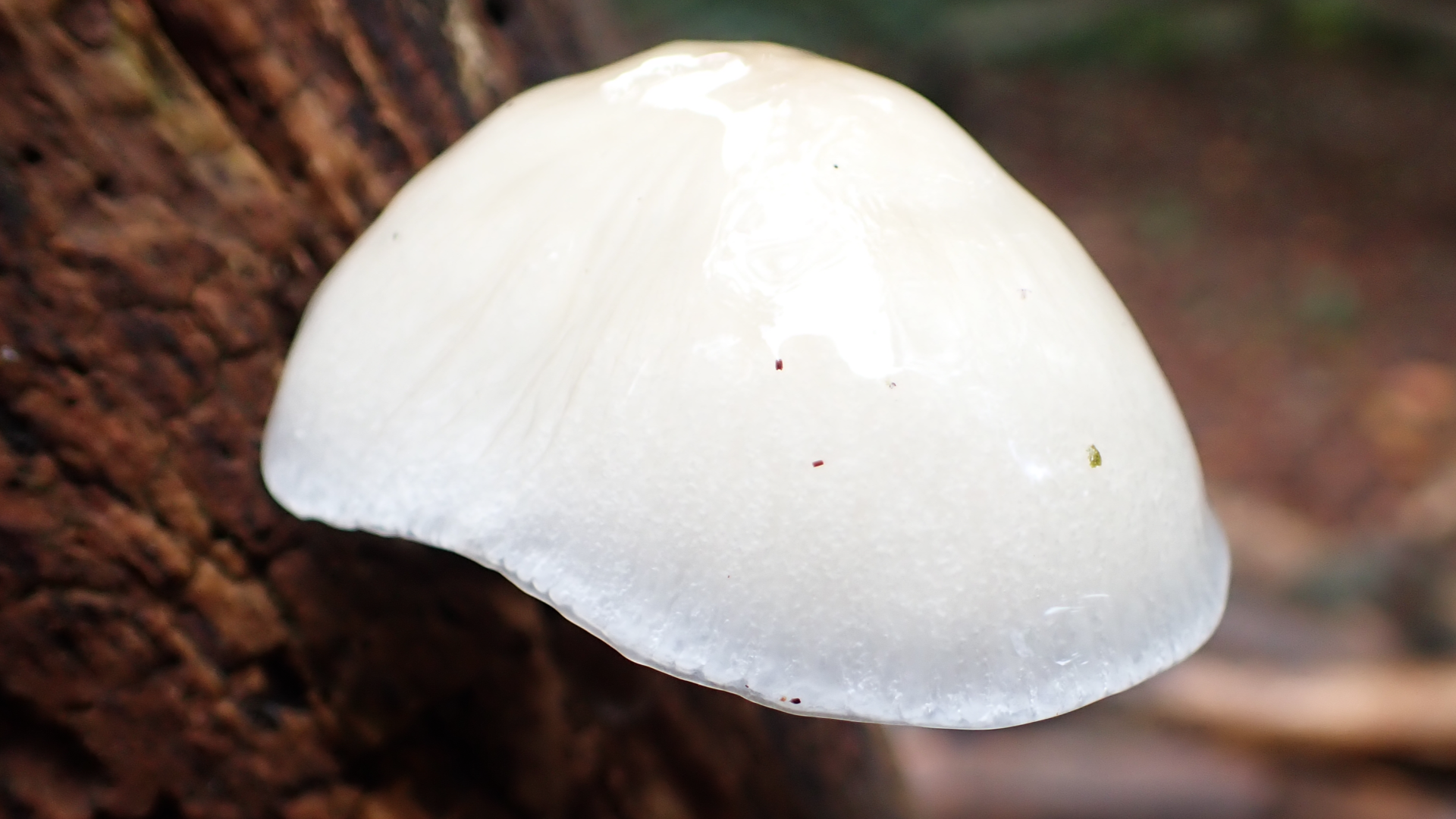
© Raymond Small TQ4792 08/10/2024
Oudemansiella mucida
Porcelain Fungus has a delicate translucent appearance. It is normally found on fallen beech trees and branches and is also known as 'Slimy Beech Tuft'.
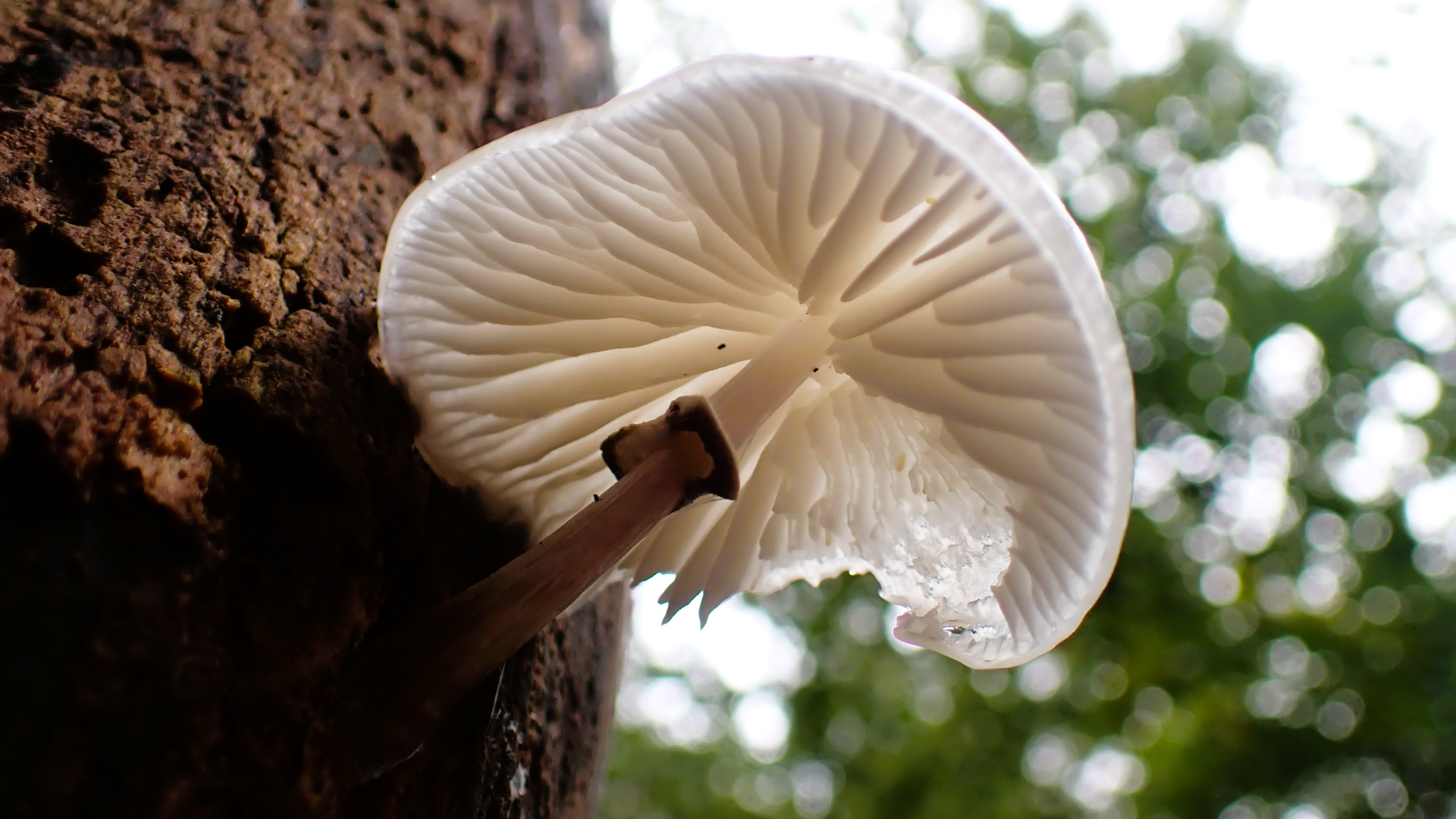
© Raymond Small TQ4792 08/10/2024
In folklore elves and fairies are often associated with living under toadstools. However, you will never find one residing beneath this species because dripping slime from the cap drives them away to drier habitats. It is also said that other fungi won't live under it and there may be some truth to this... the slime is said to contain a fungicide that kills them off. Only two caps have been seen so far this year and both appeared to have been chewed by something (possibly a deer).
SULPHUR TUFT
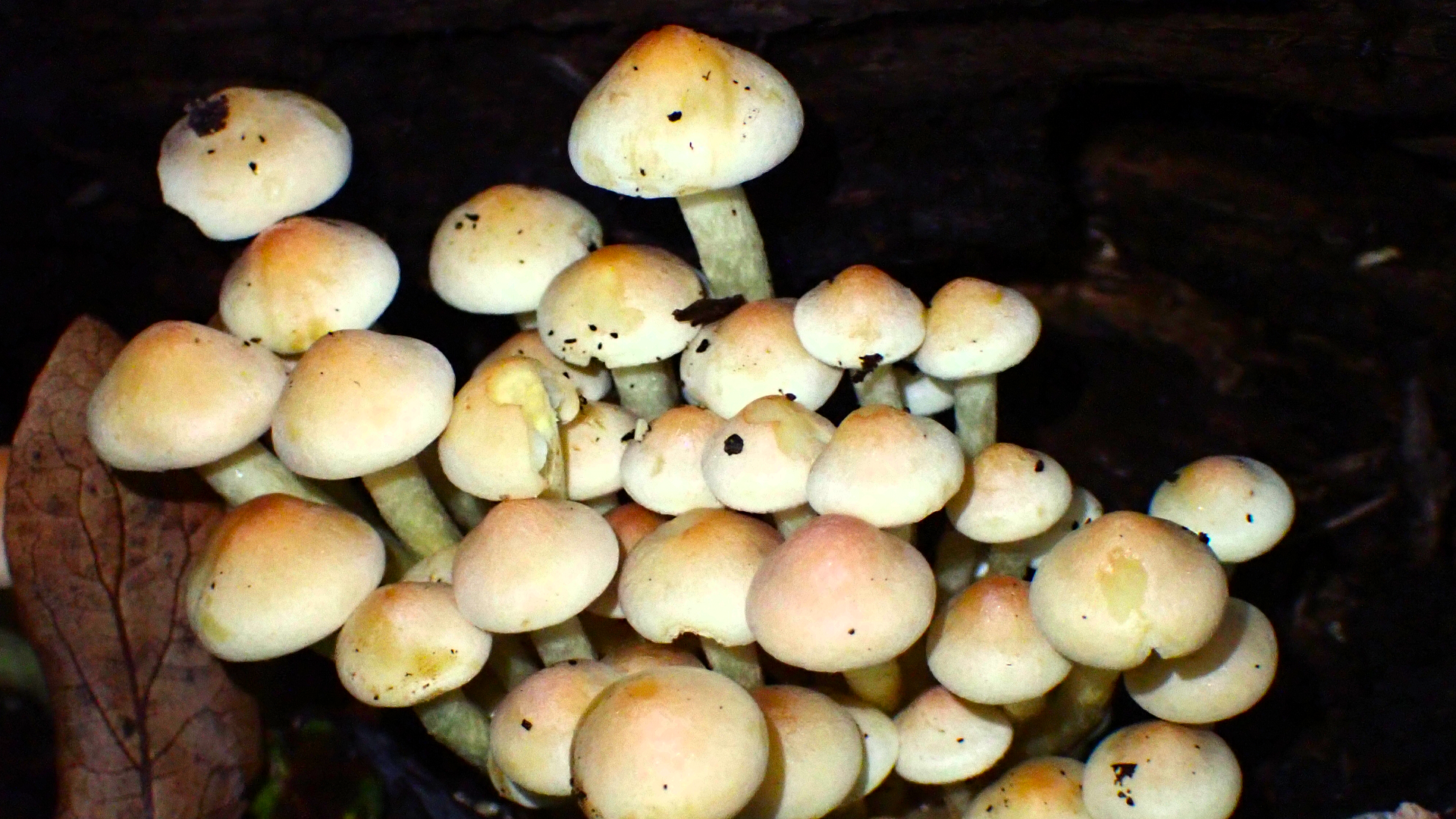
© Raymond Small TQ4792 04/10/2024
Hypholoma fasciculare
This common species grows in tufts throughout the year on deadwood.
COMMON PARASOL
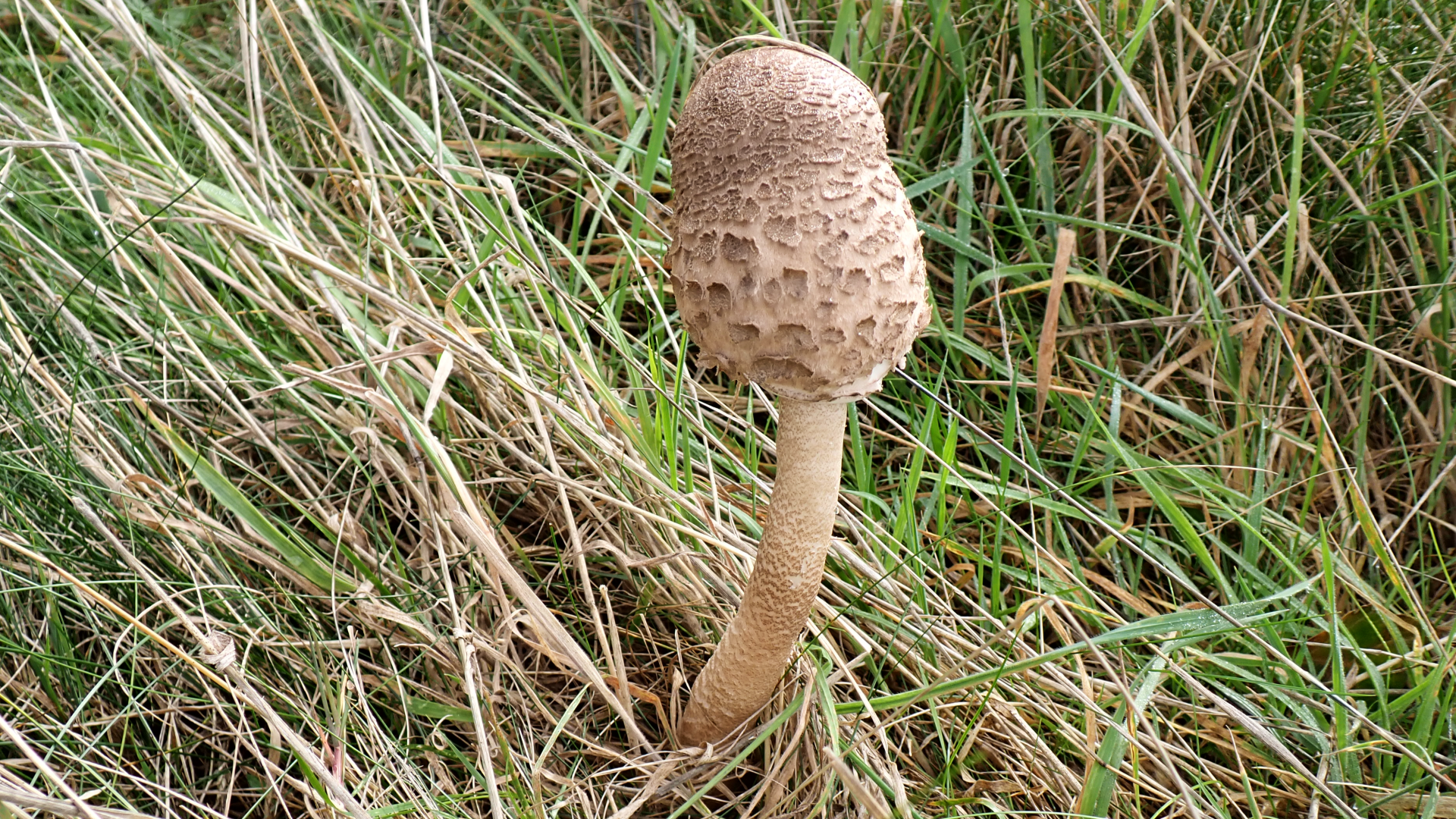
© Raymond Small TQ4892 06/10/2024
Macrolepiota procera
The Common Parasol has a whitish-buff cap covered with large dark brown scales. The cap is initially egg-shaped, flattening and developing a dark central bump.
SHAGGY PARASOL
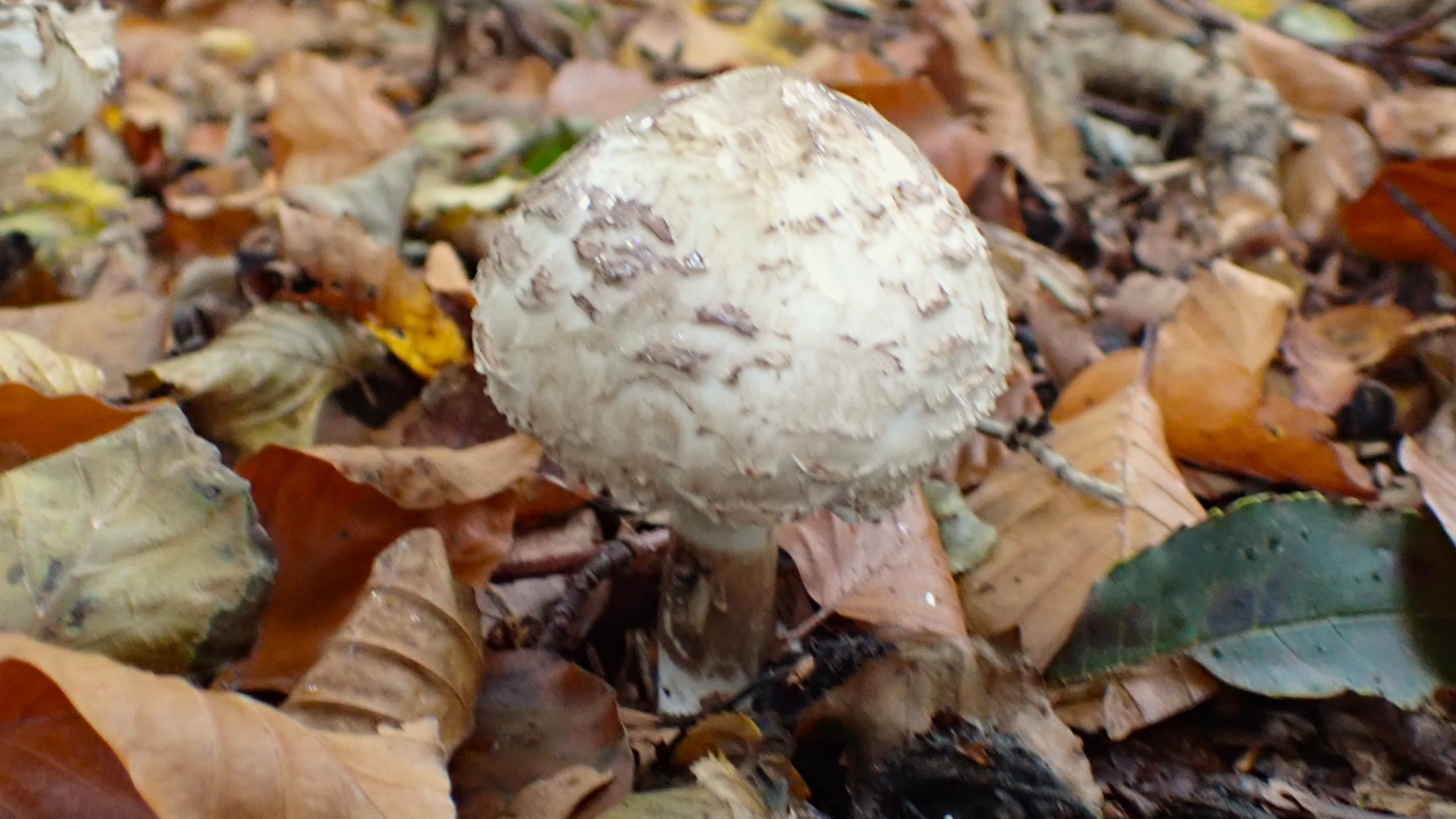
© Raymond Small TQ4792 20/10/2024
Chlorophyllum rhacodes
The Shaggy Parasol normally has a stockier appearance than the Common Parasol. The rounded white cap flattens and has dark brown scales giving it a 'shaggy' look. The flesh bruises red when damaged.
TURKEYTAIL
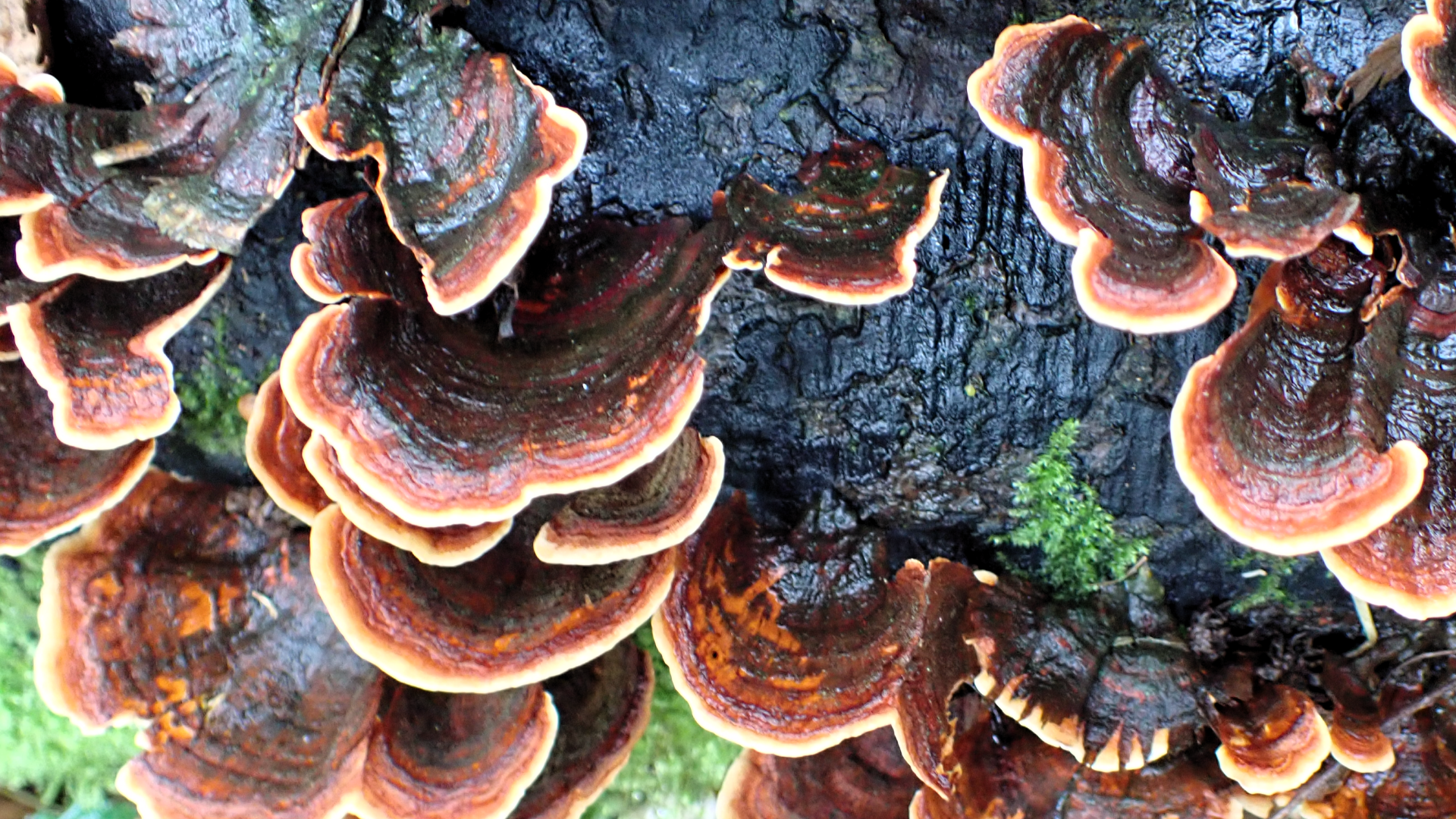
© Raymond Small TQ4792 08/10/2024
Trametes versicolor
Turkeytail usually occurs in large, tiered groups on hardwood throughout the year. Fan-like with variable coloured concentric rings, the thin, wavy, edge is always white or creamy. The brackets measure 4-10cm across.
ASCOMYCETES FUNGUS
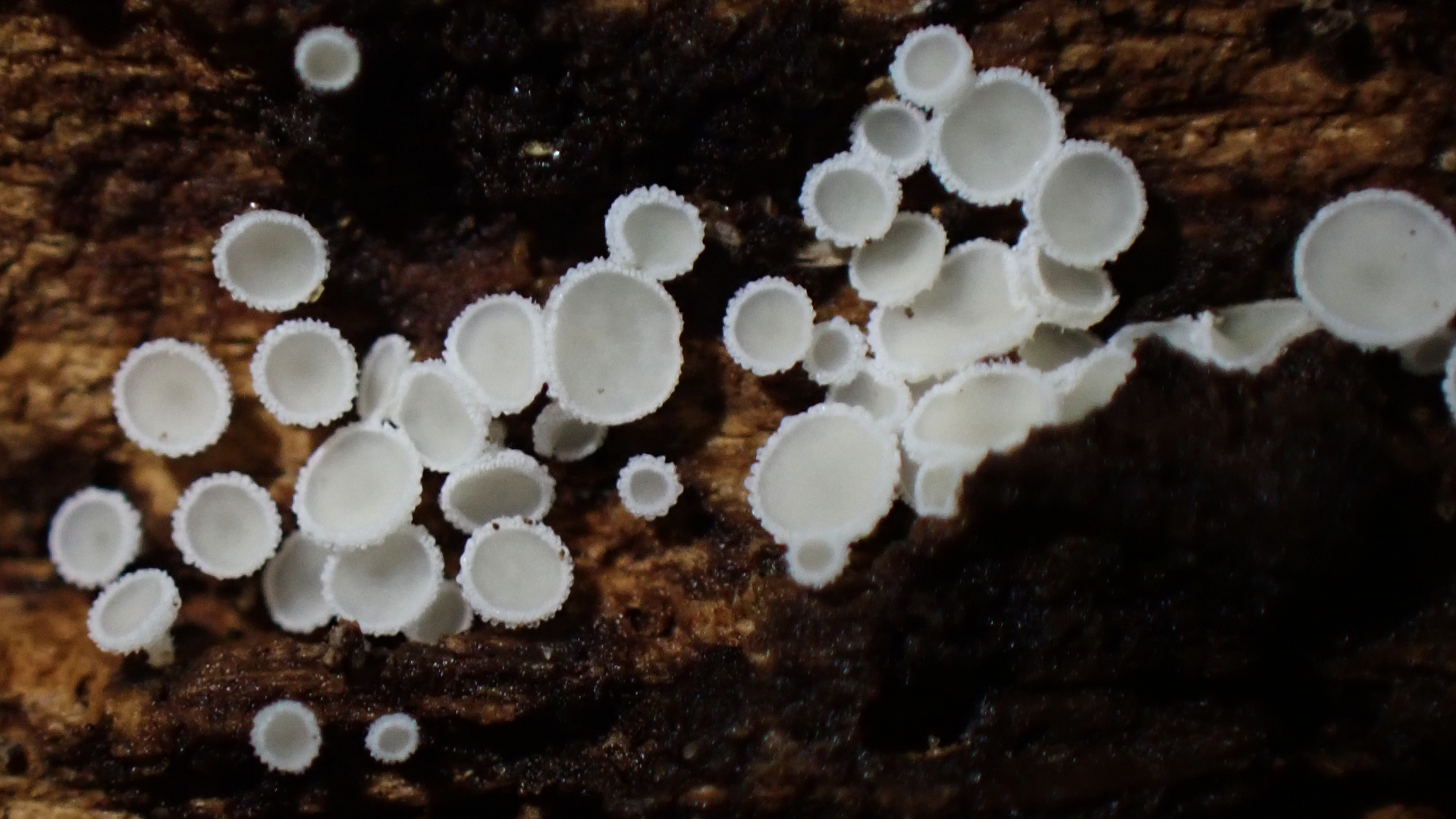
© Raymond Small TQ4893 16/10/2024
Lachnum brevipilosum
The stalked cups of this fungus measure 1-2mm across. They can be found all through the year by turning dead deciduous wood that has been laying on damp ground. Because of their tiny size the cups can easily go unnoticed.
EUROPEAN PEAR RUST
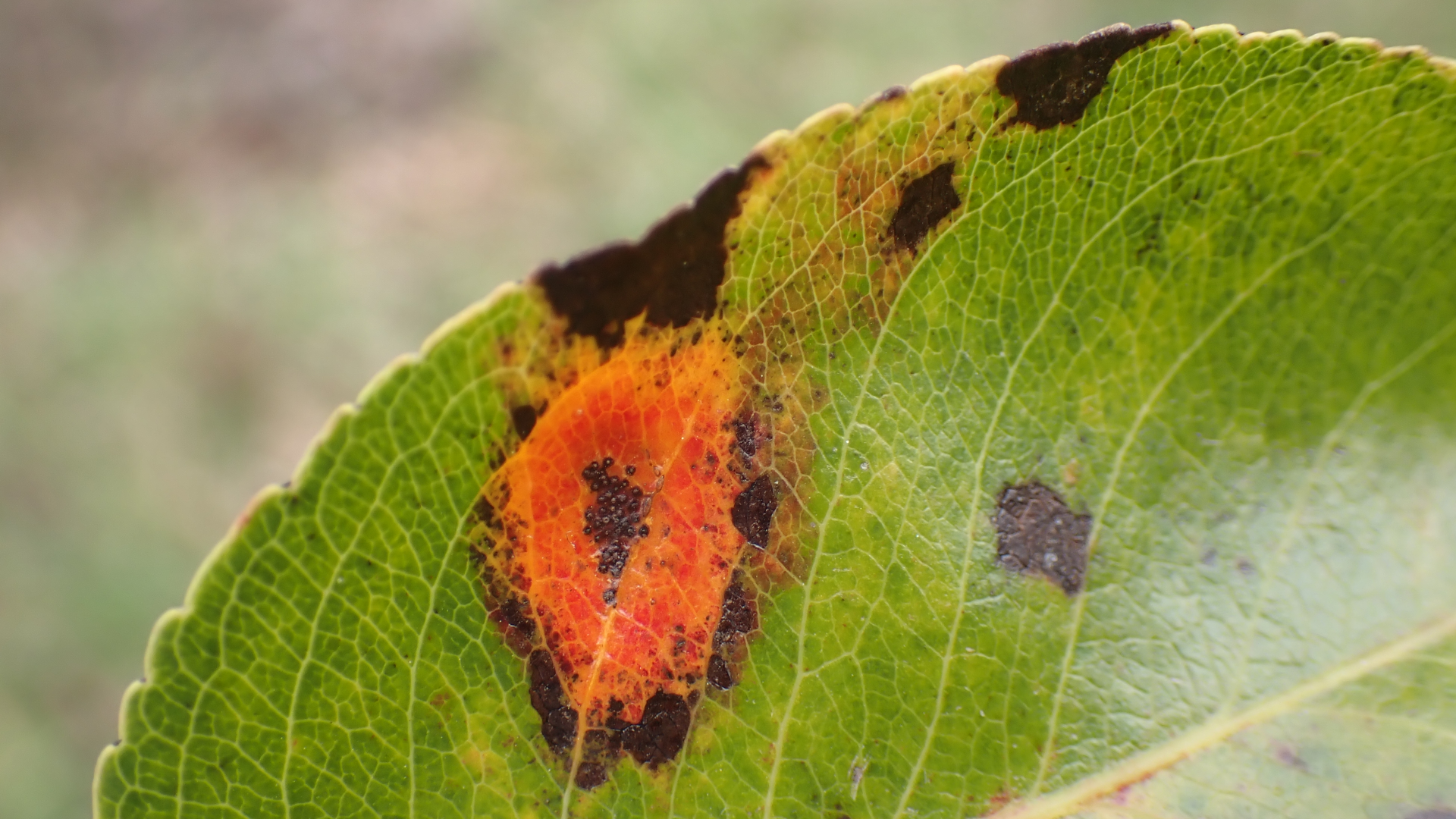
© Raymond Small TQ4792 06/10/2024
Gymnosporangium sabinae
Juniper trees play host to this fungus during winter and pear trees become the secondary host in the summer. This rust fungus needs both juniper and pear trees to complete its life cycle. On pear trees the fungus creates orange patches on the upper surface of leaves.
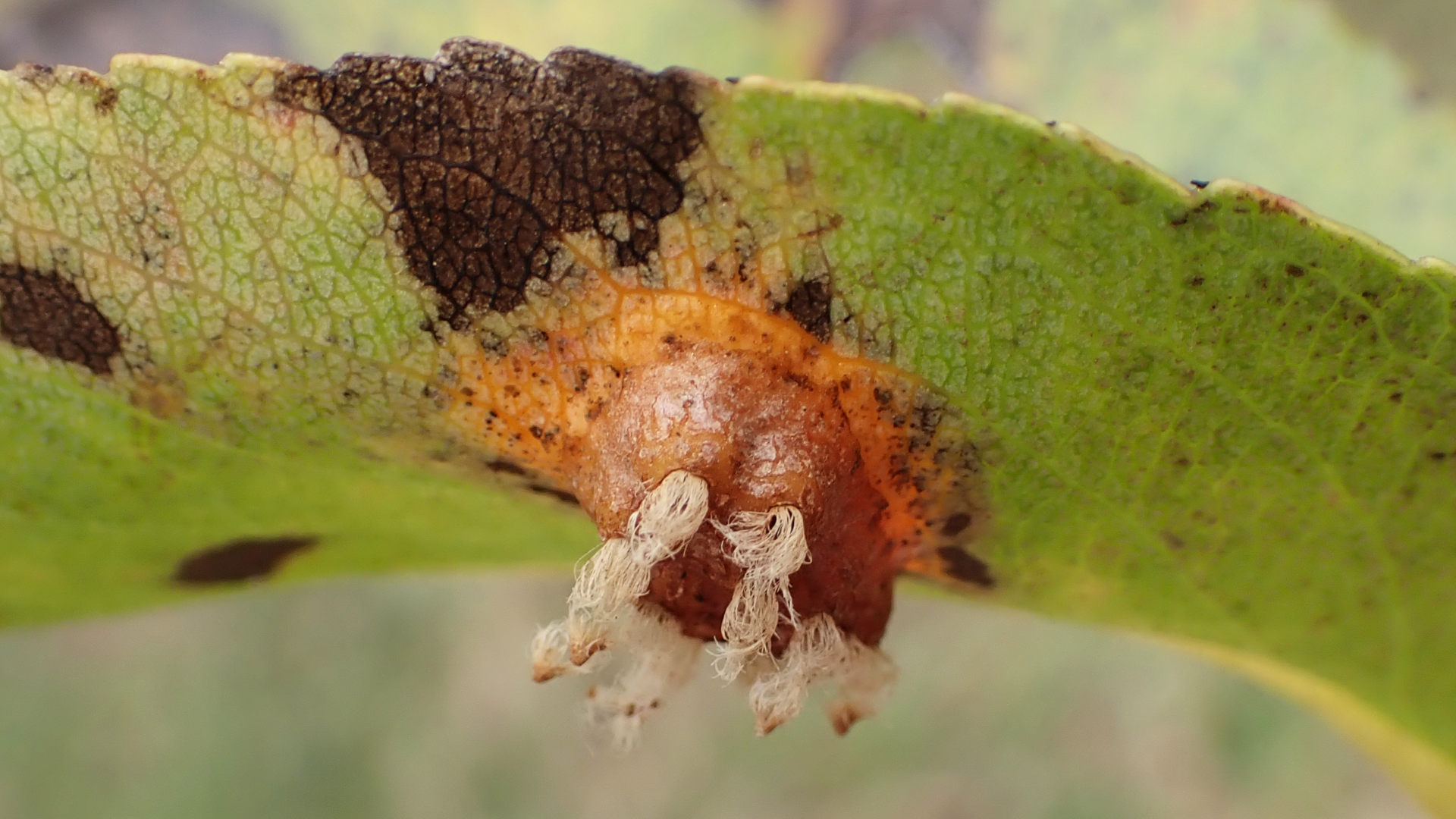
© Raymond Small TQ4792 06/10/2024
Blisters appear on the underside of pear leaves in which spores develop. The spores are spread by the wind to infect juniper trees.
SCRAMBLED EGG SLIME MOULD
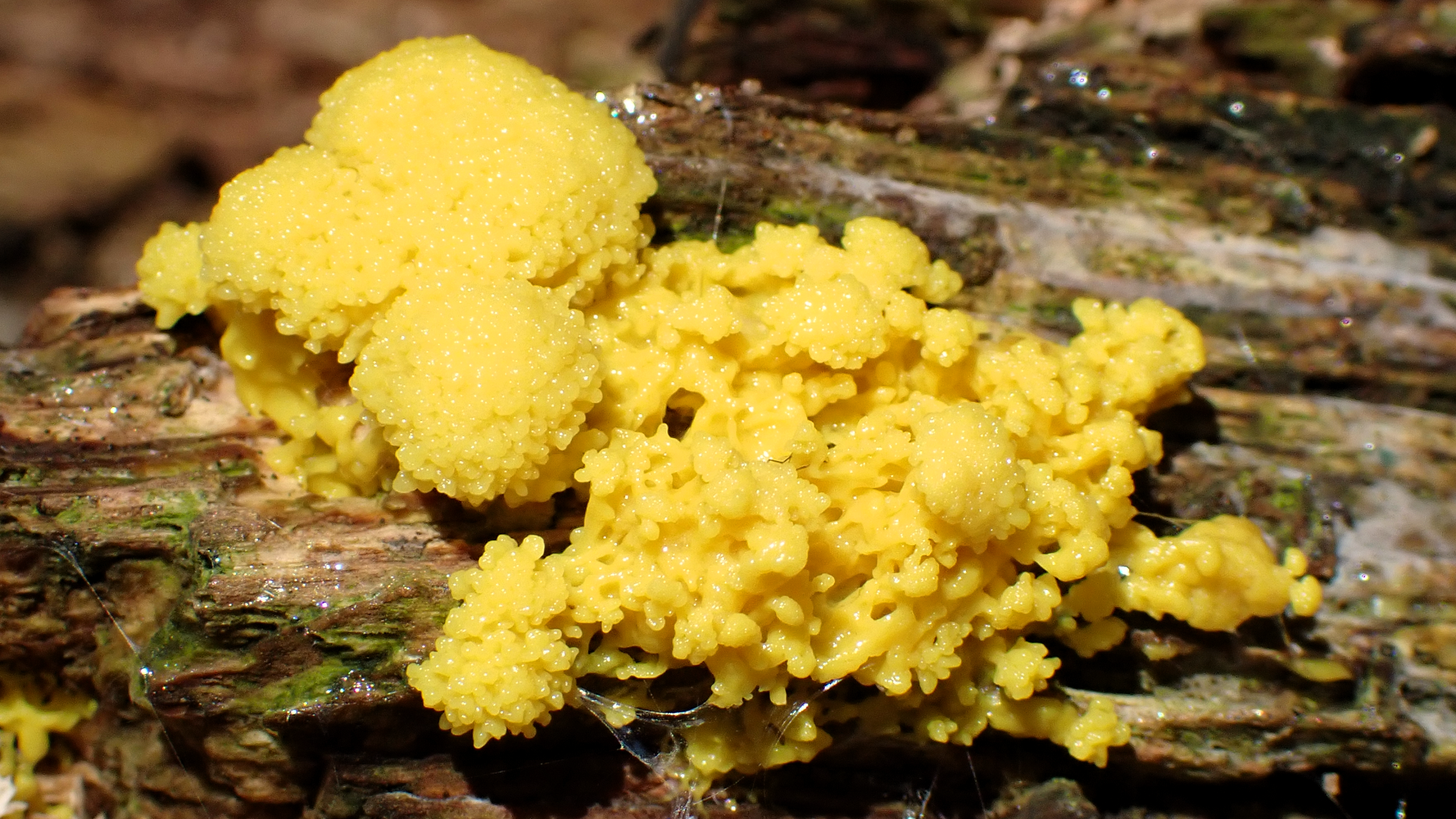
© Raymond Small TQ4792 04/10/2024
Fuligo septica
Not surprisingly this slime mould is known by the common name Scrambled Egg. It grows on dead wood and is usually found on stumps and fallen trees.
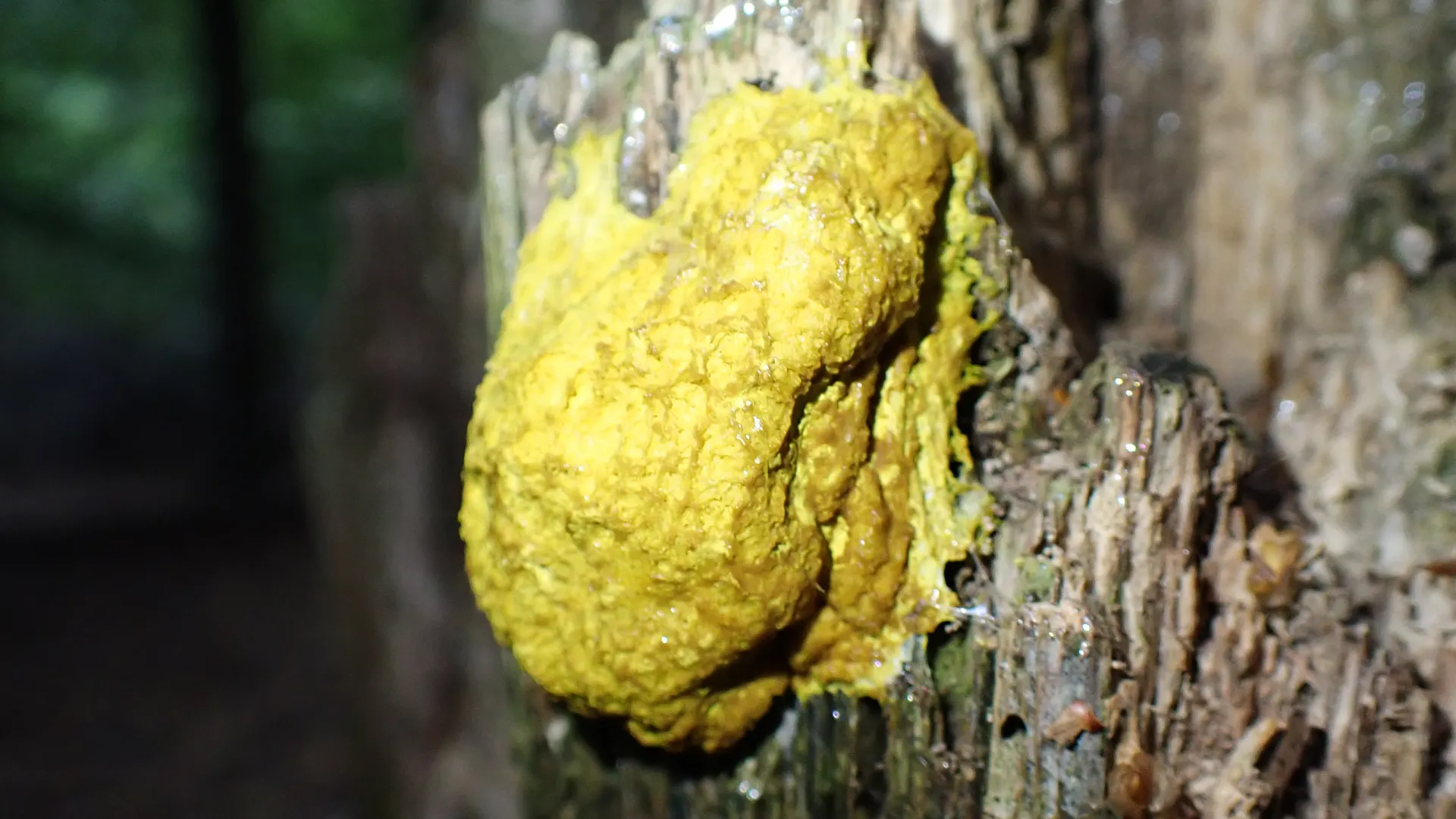
© Raymond Small TQ4792 06/10/2024
The Scrambled Egg hardens...
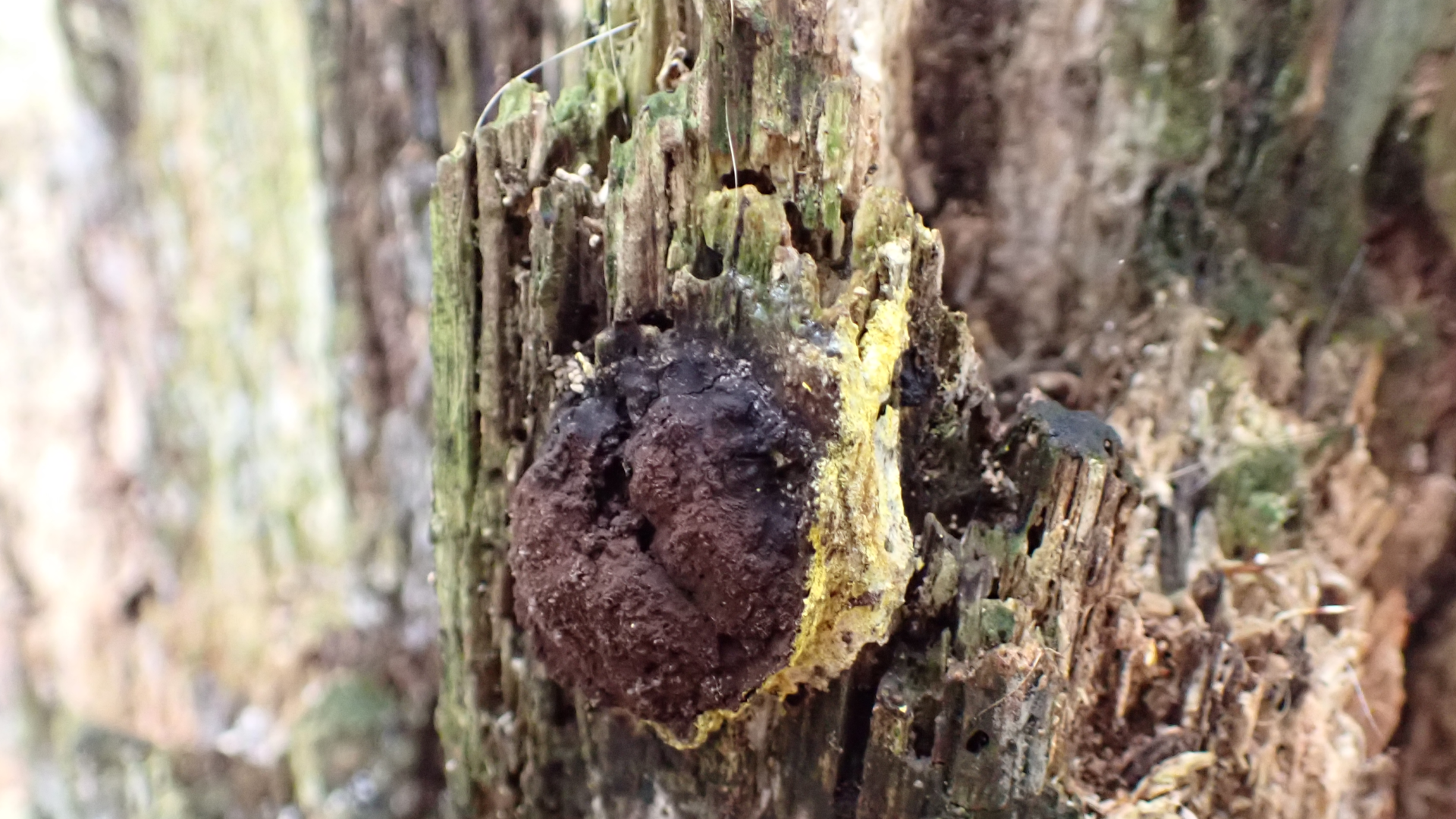
© Raymond Small TQ4792 20/10/2024
...then darkens and disintegrates to release its spores.
ORANGE LADYBIRD
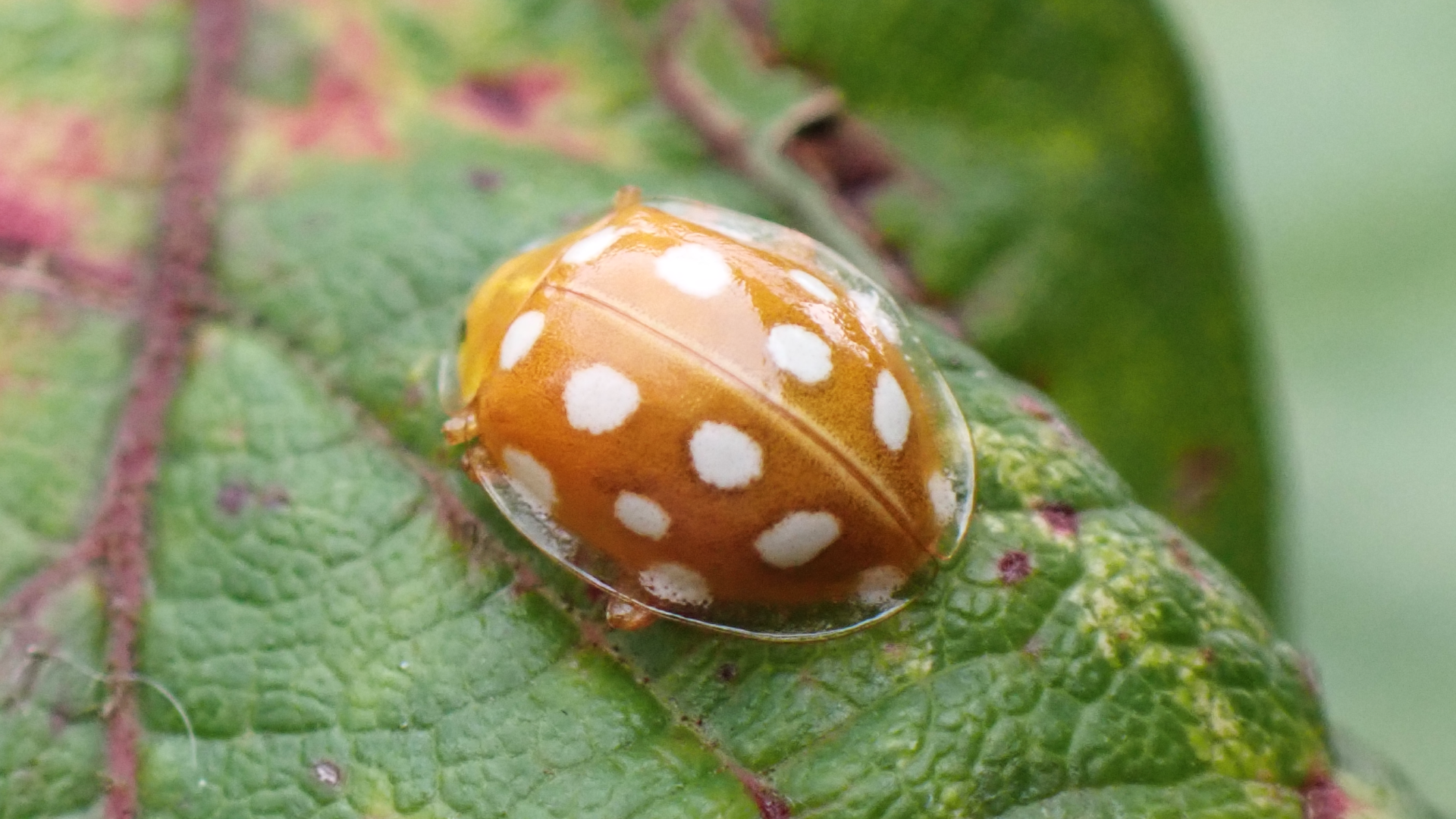
© Raymond Small TQ4792 06/10/2024
Halyzia sedecimguttata
The Orange Ladybird has up to 16 whitish spots. The wing cases have transparent edges. This species feeds on mildew on trees like sycamore, ash and beech. It hibernates in leaf litter.
HARLEQUIN LADYBIRD
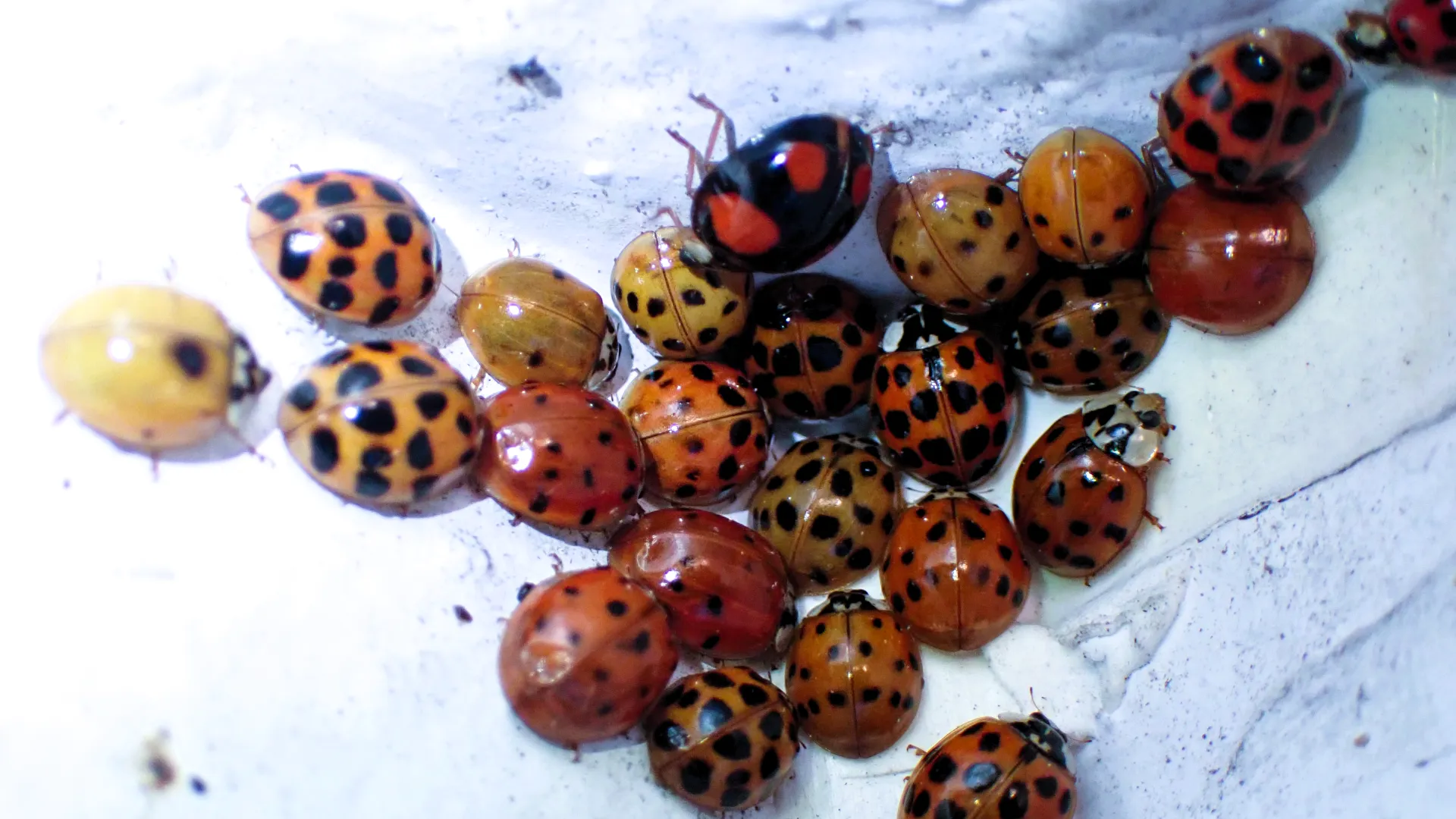
© Raymond Small TQ4792 16/10/2024
Harmonia axyridis
Vision's office at Foxburrow Barn had a Ladybird infestation. Sometimes they enter buildings through cracks in window frames or gaps around doors when seeking shelter. The Harlequin ladybird is an invasive species from Eastern Asia that established itself in Britain during 2004 and has now become widespread across south-east England. It is very variable in colour and markings, measuring 8-10mm in length. These pictures show variants sheltering in corners around the entrance door.
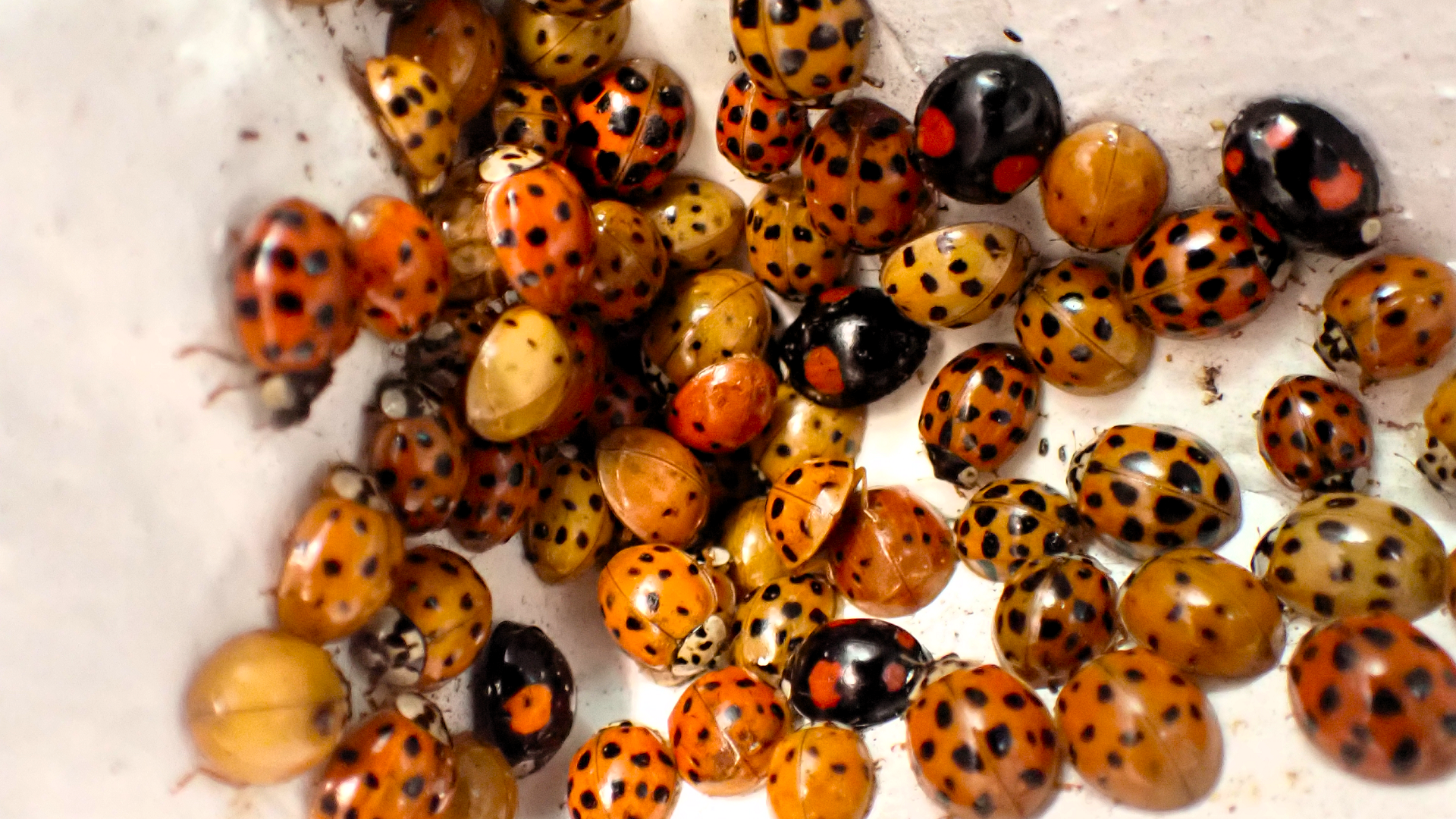
© Raymond Small TQ4792 18/10/2024
As the weather cools ladybirds get prepared for hibernation, a period of suspended development in insects known as diapause. Some species do this alone in cracks while others form large clusters in sheltered places. When the diapause ends with the warm spring weather they will wake up to mate and egg lay.
ORB WEB
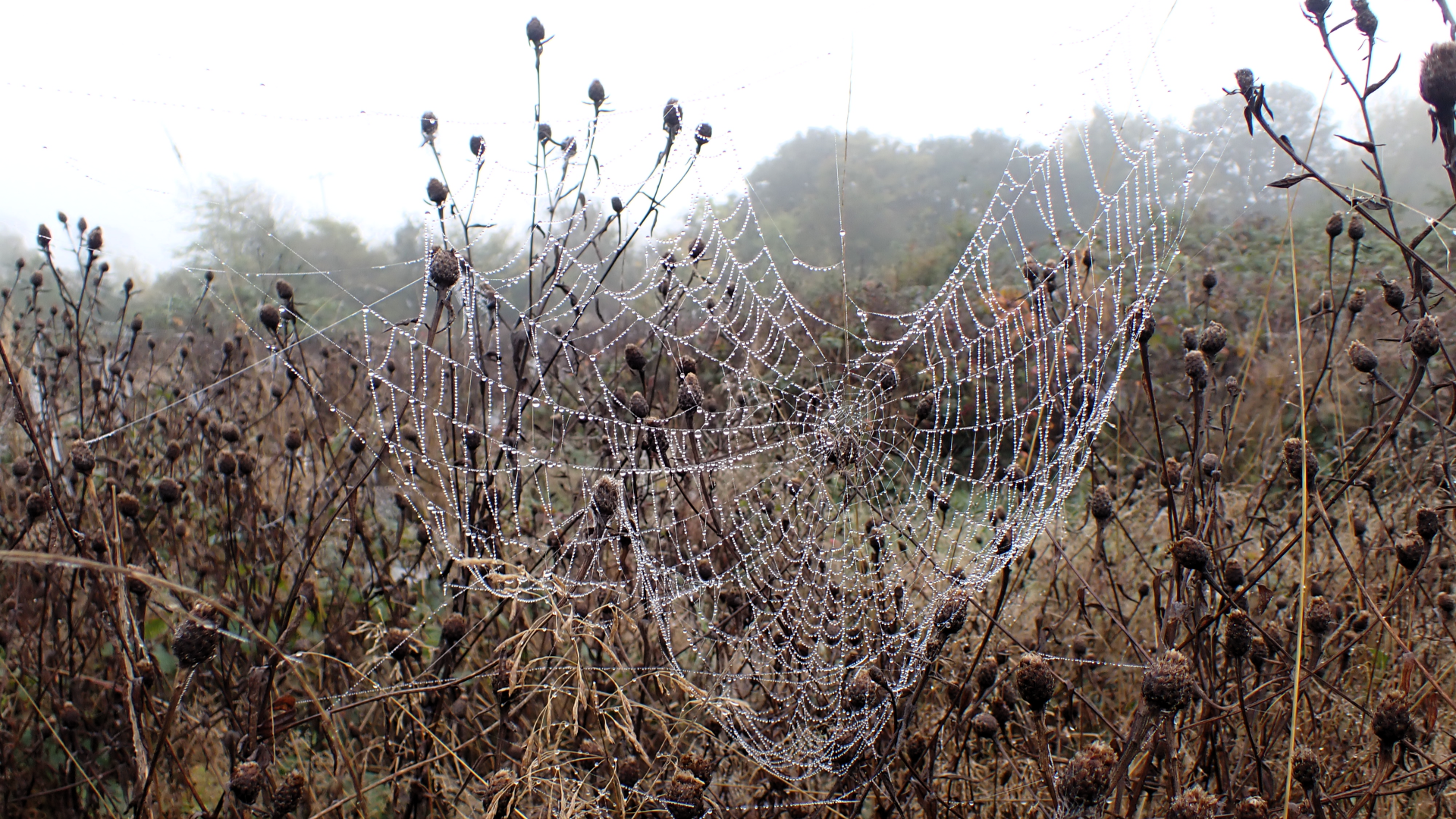
© Raymond Small TQ4792 18/10/2024
Webs are an efficient way for spiders to trap prey because it means they do not spend energy chasing a meal. However, spinning a web is not cost free and a huge amount of energy is spent making the silk. Over time the silk loses adhesiveness and becomes ineffective. Many spiders resort to eating their web daily to recycle the silk proteins enabling them to spin a fresh web.
STONECHAT
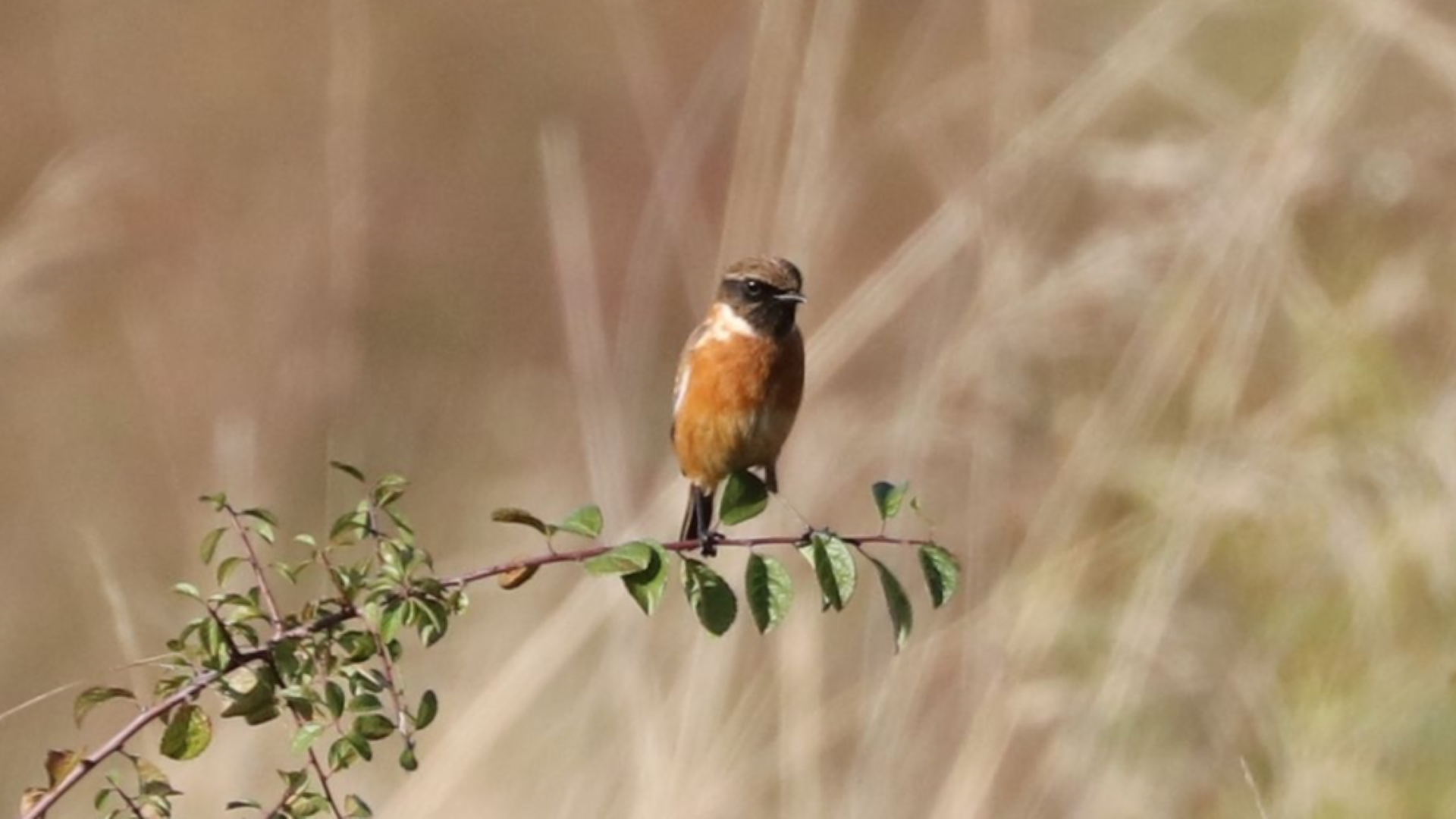
© Michael Trump TQ4793 15/10/2024
Saxicola rubicola
Stonechats are small birds about the size of a robin. They are usually winter visitors to Hainault Forest. This male was photographed on the scrub area on Millennium Hill.
EGYPTIAN GEESE
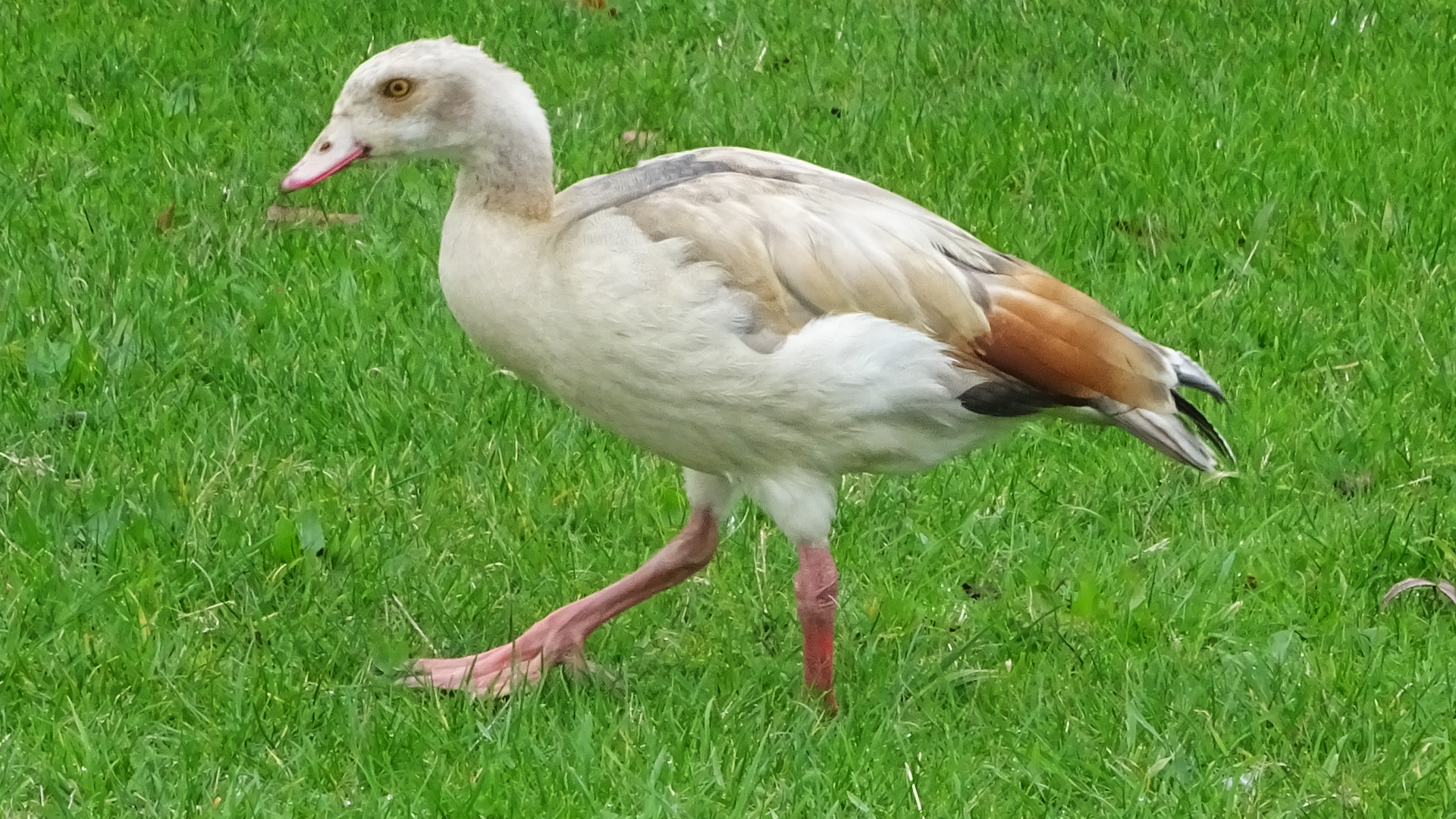
© Raymond Small TQ4792 12/10/2024
Alopochen aegyptiaca
Young Egyptian Geese do not have dark eye patches like the adults do.
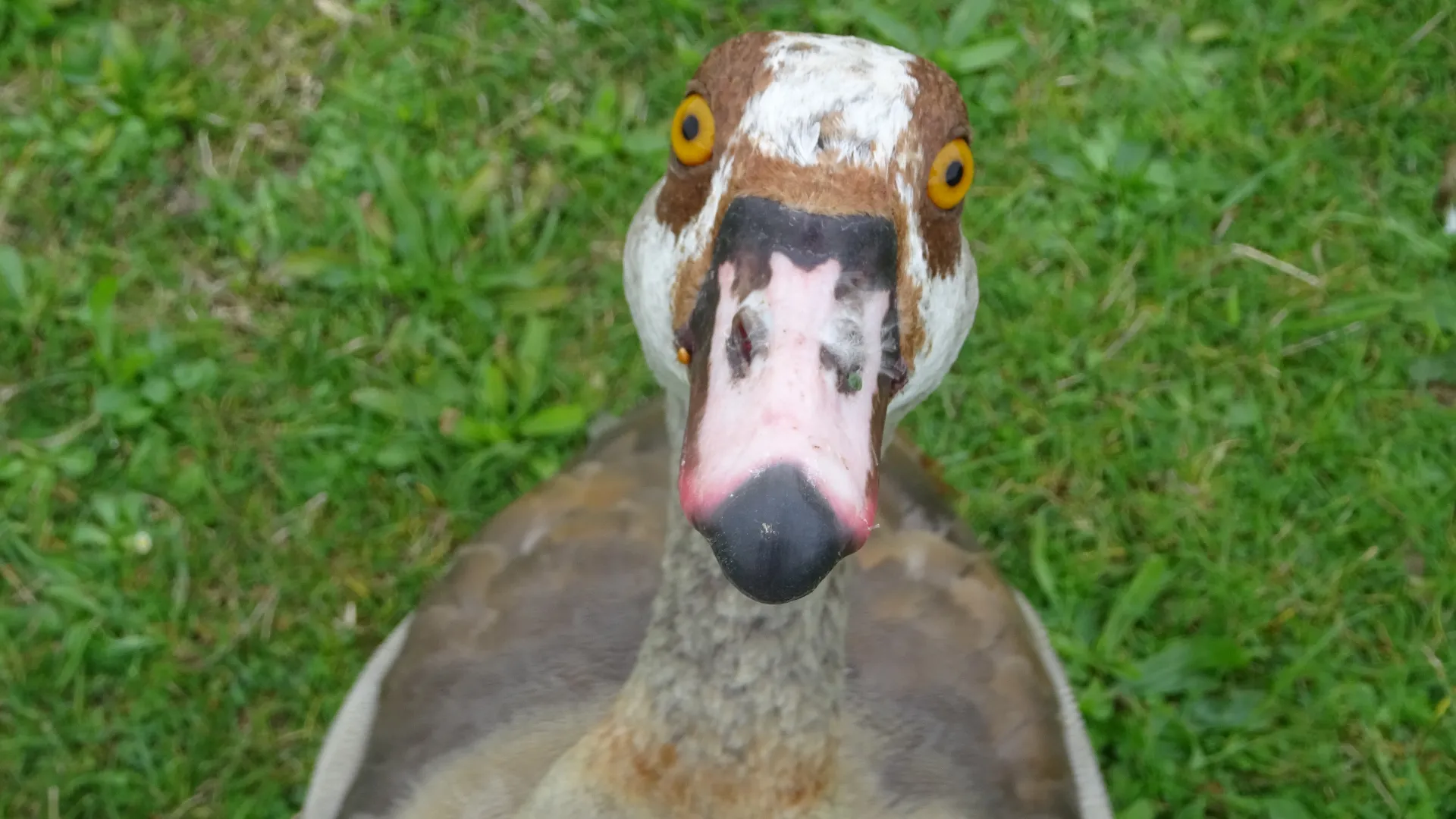
© Raymond Small TQ4792 12/10/2024
Egyptian geese have a preference for open grassland near freshwater where they can nest in tree cavities and have been known to move into crow and raptor nests.
PEAFOWL
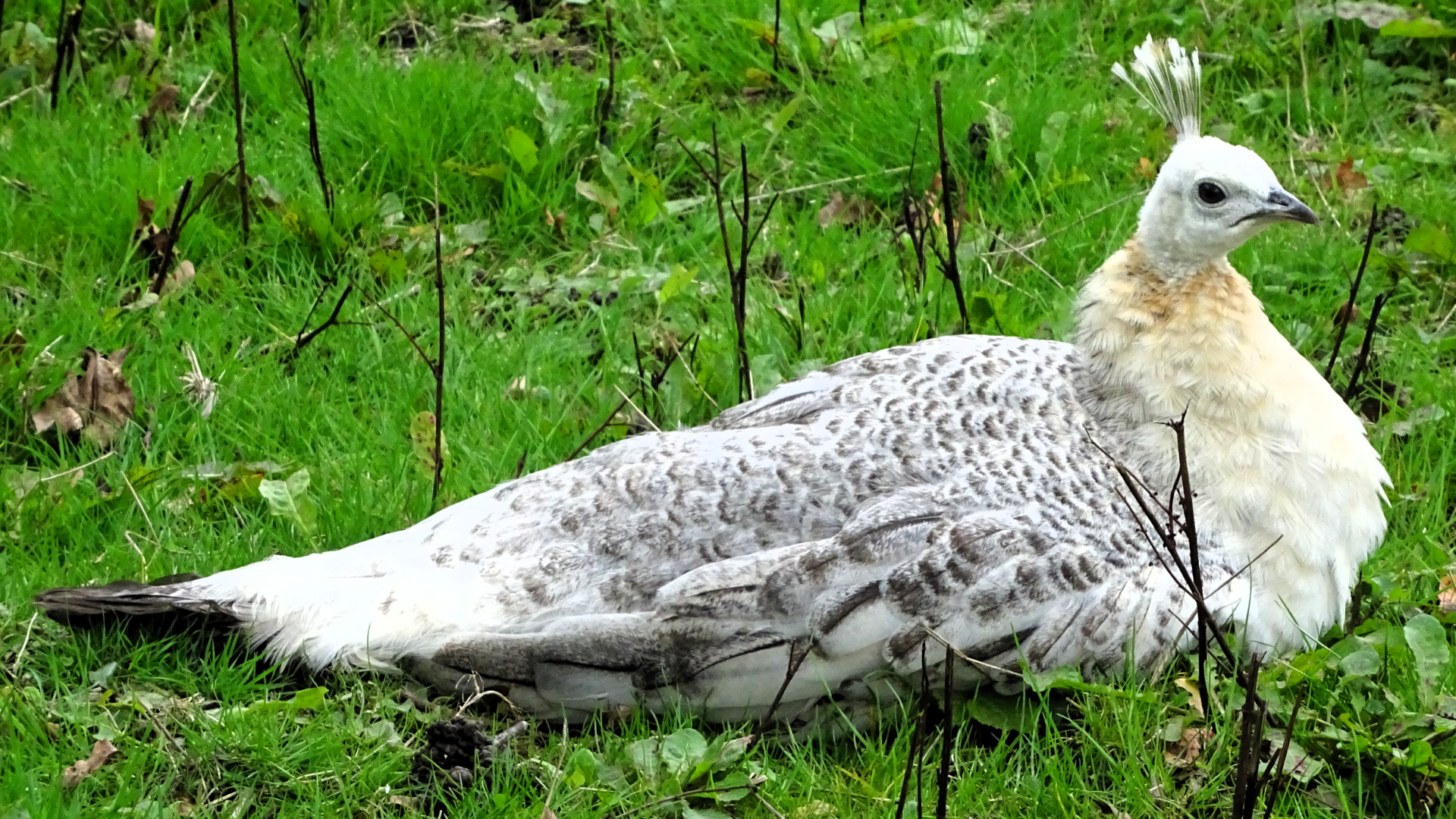
© Raymond Small TQ4792 06/10/2024
Female Peafowl are known as 'Peahens'. Females have drabber colours and shorter tails than the males known as 'Peacocks'. They also have a different call when communicating. Peafowl can be seen at Foxburrow Farm.
CORRESPONDENCE
(Emails received this month)
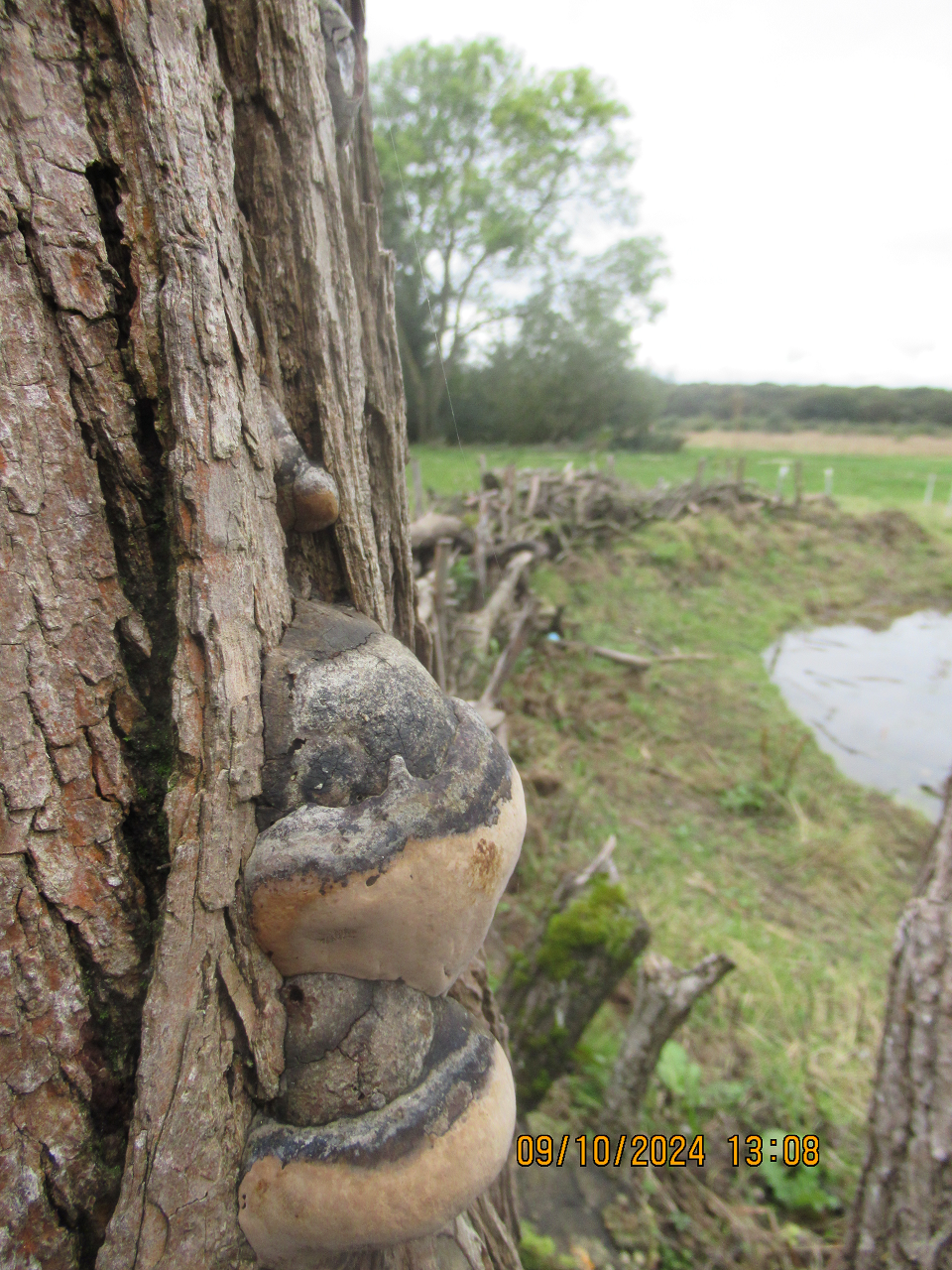
Brian Ecott emailed this picture of Willow Bracket near Foxburrow Farm pond.
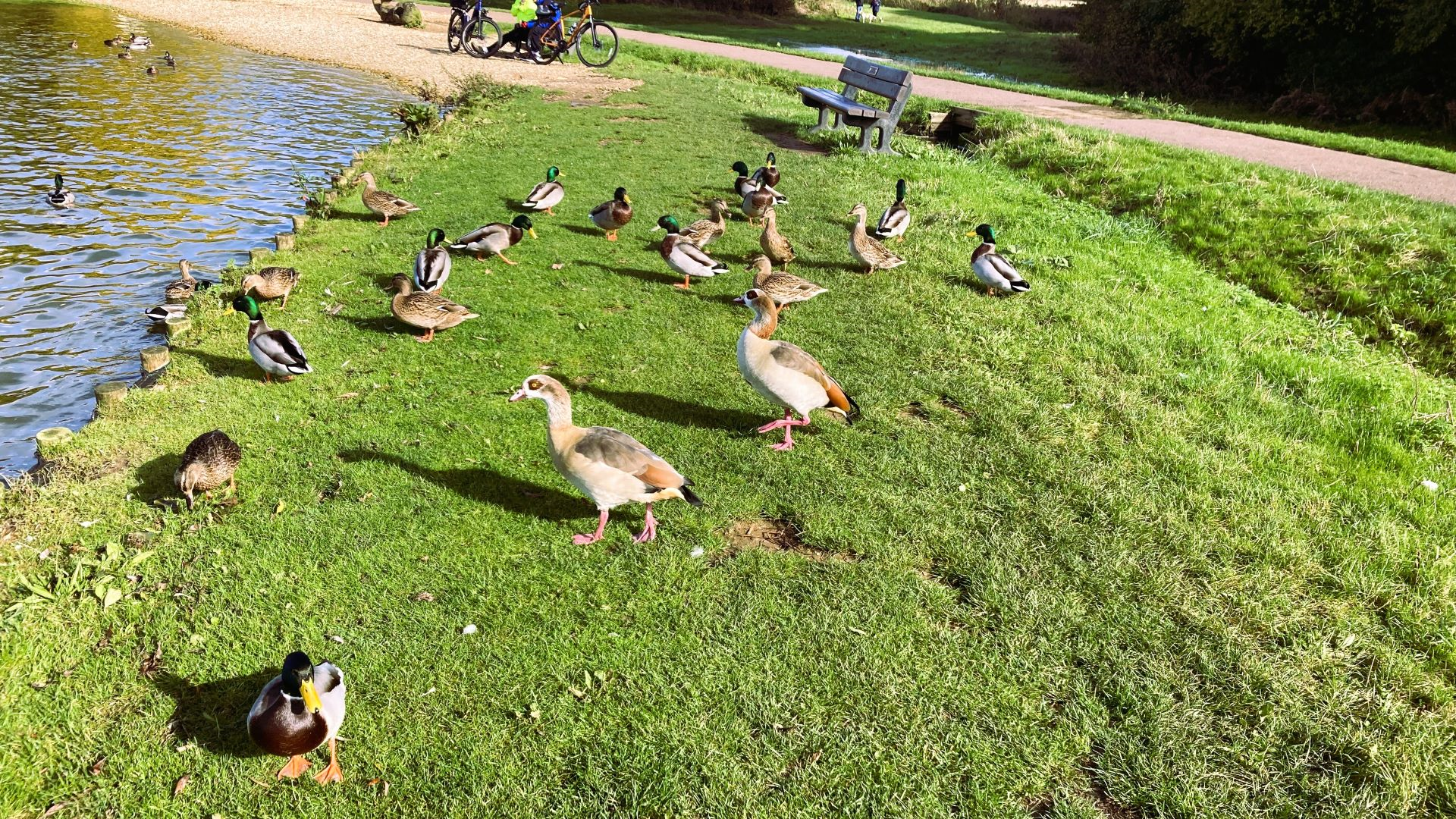
Roger Smith sent this picture from his local park in Bedford: "A couple of Egyptian geese this morning, but still no swans!"
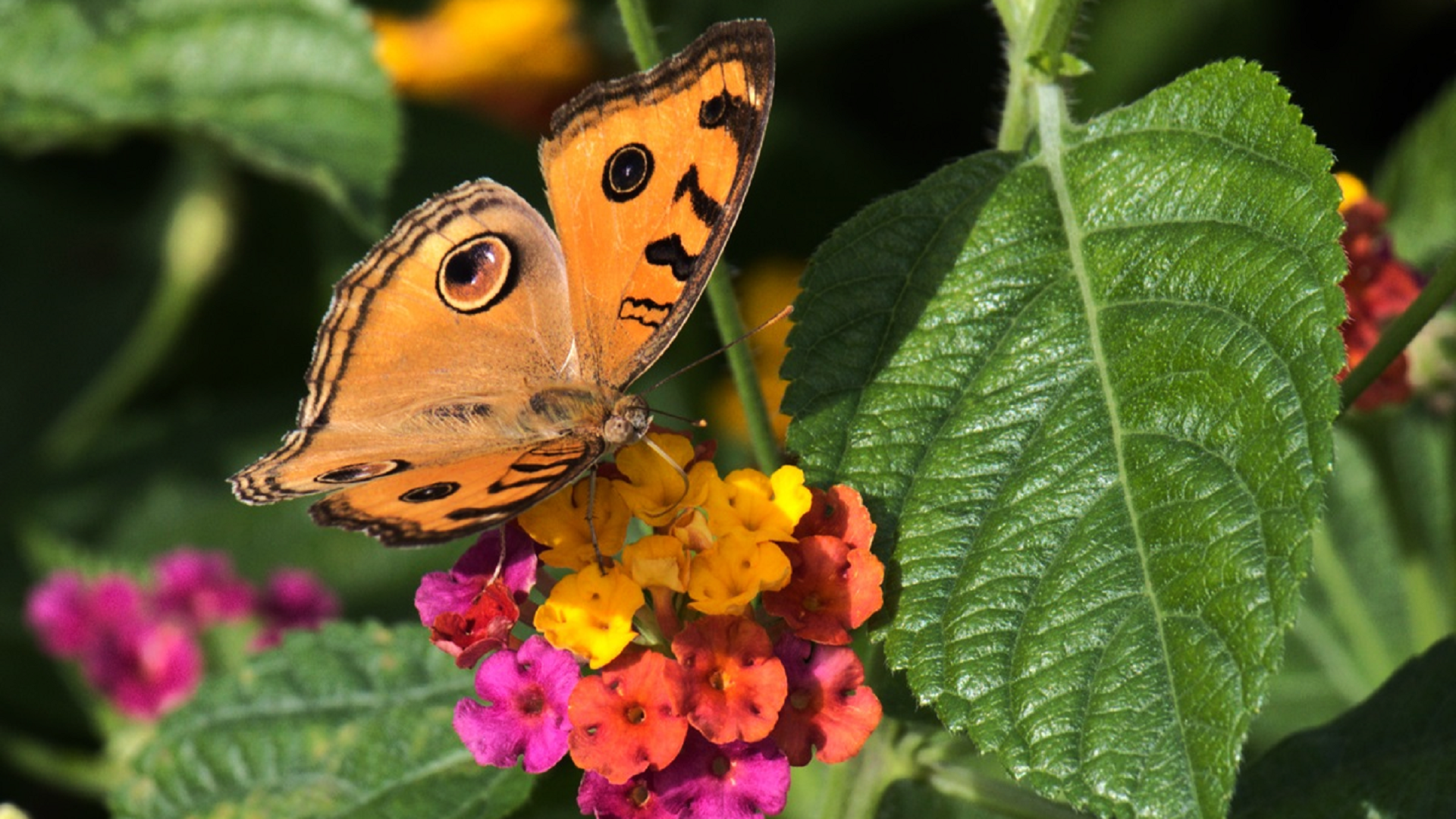
Mike Rumble returned from Vietnam recently and thought these pictures would be appreciated. The Peacock Pansy has large eye-spots on the wings, a characteristic shared with the Peacock butterfly found in Britain.
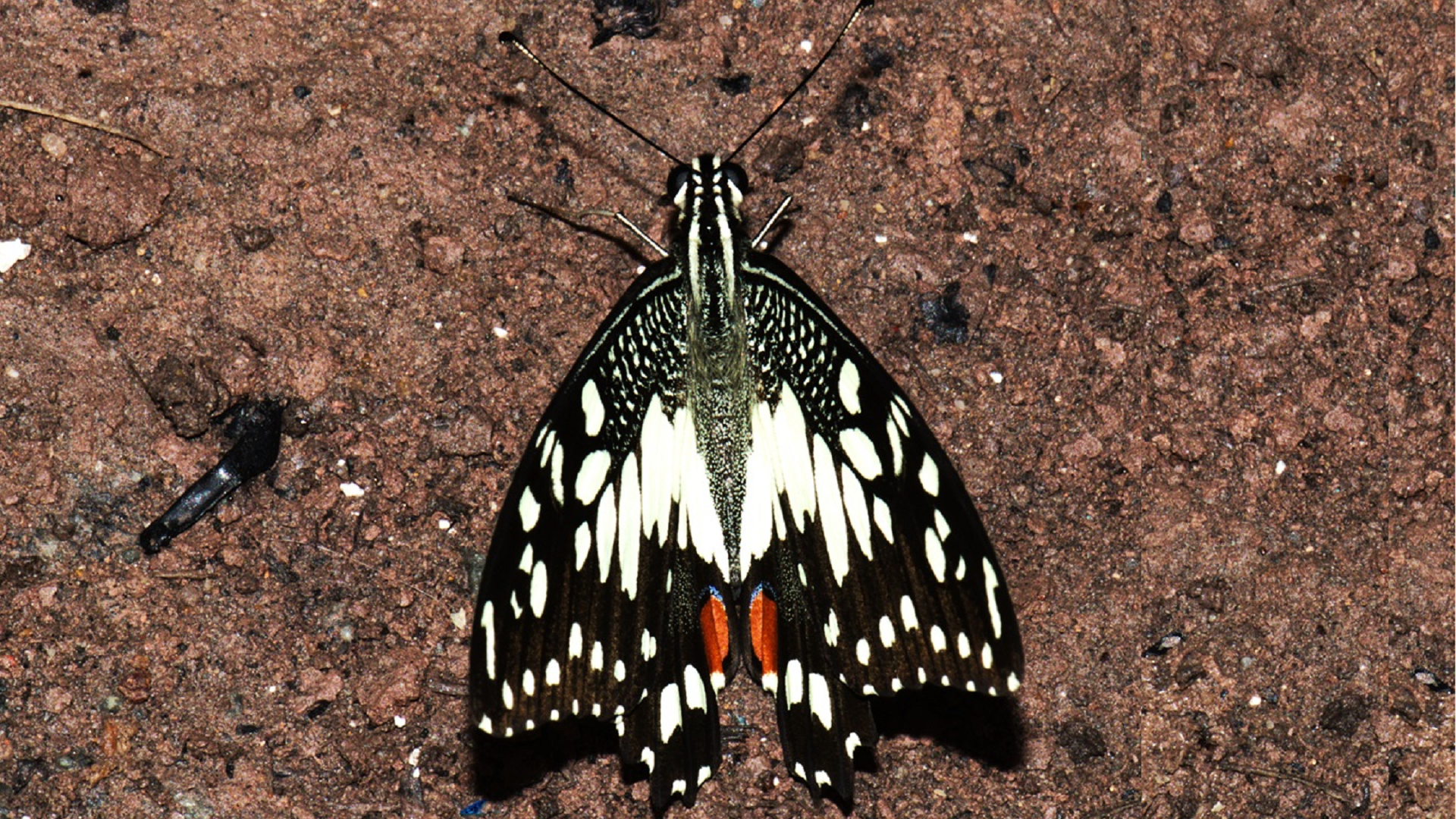
The Lime Swallowtail is another stunning Asian butterfly.
AND FINALLY...
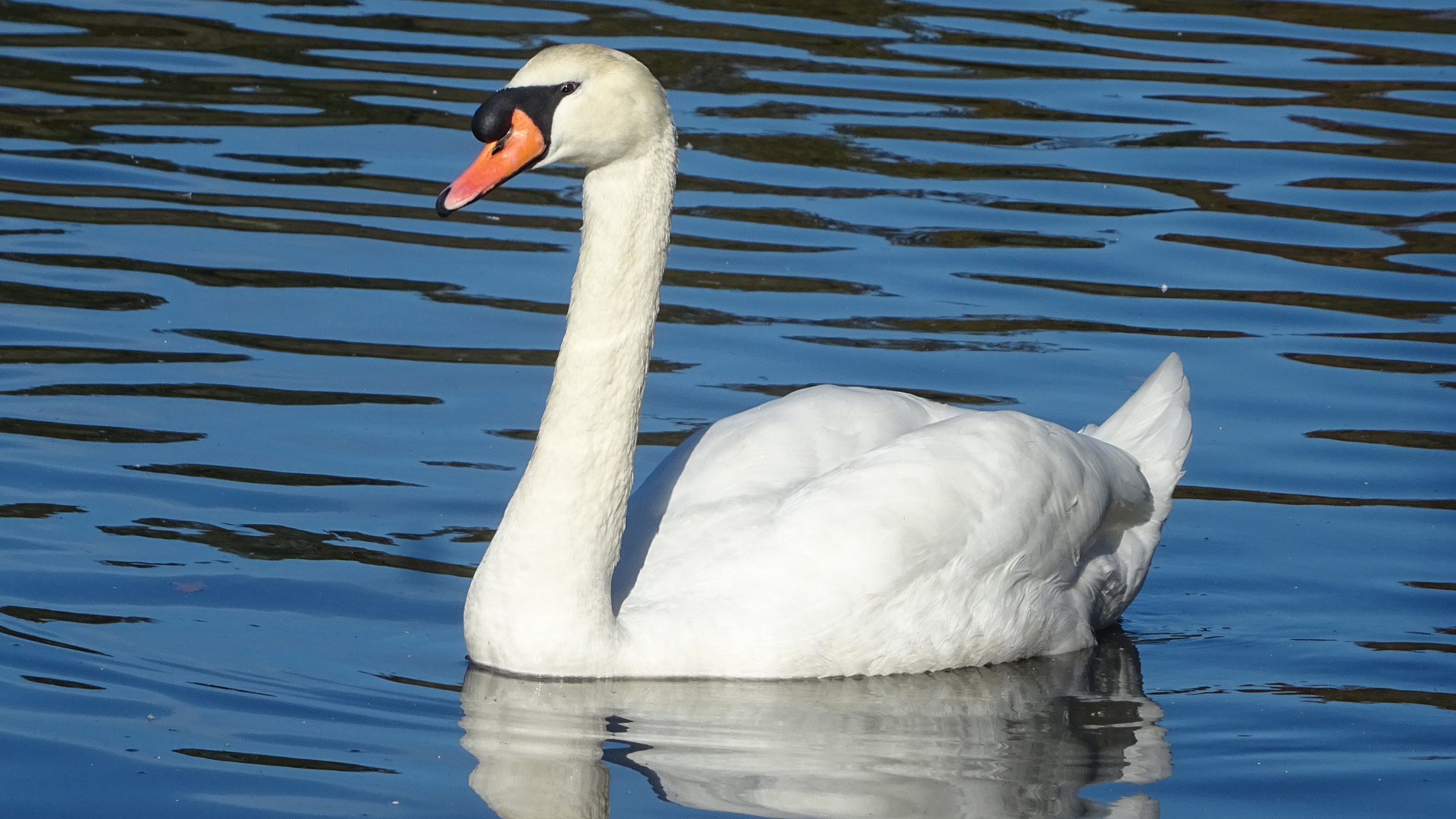
© Raymond Small TQ4792 27/10/2024
Cygnus olor
And finally... some good news. Two Mute Swans appeared on Hainault Lake at the end of October after being absent for most of the year.
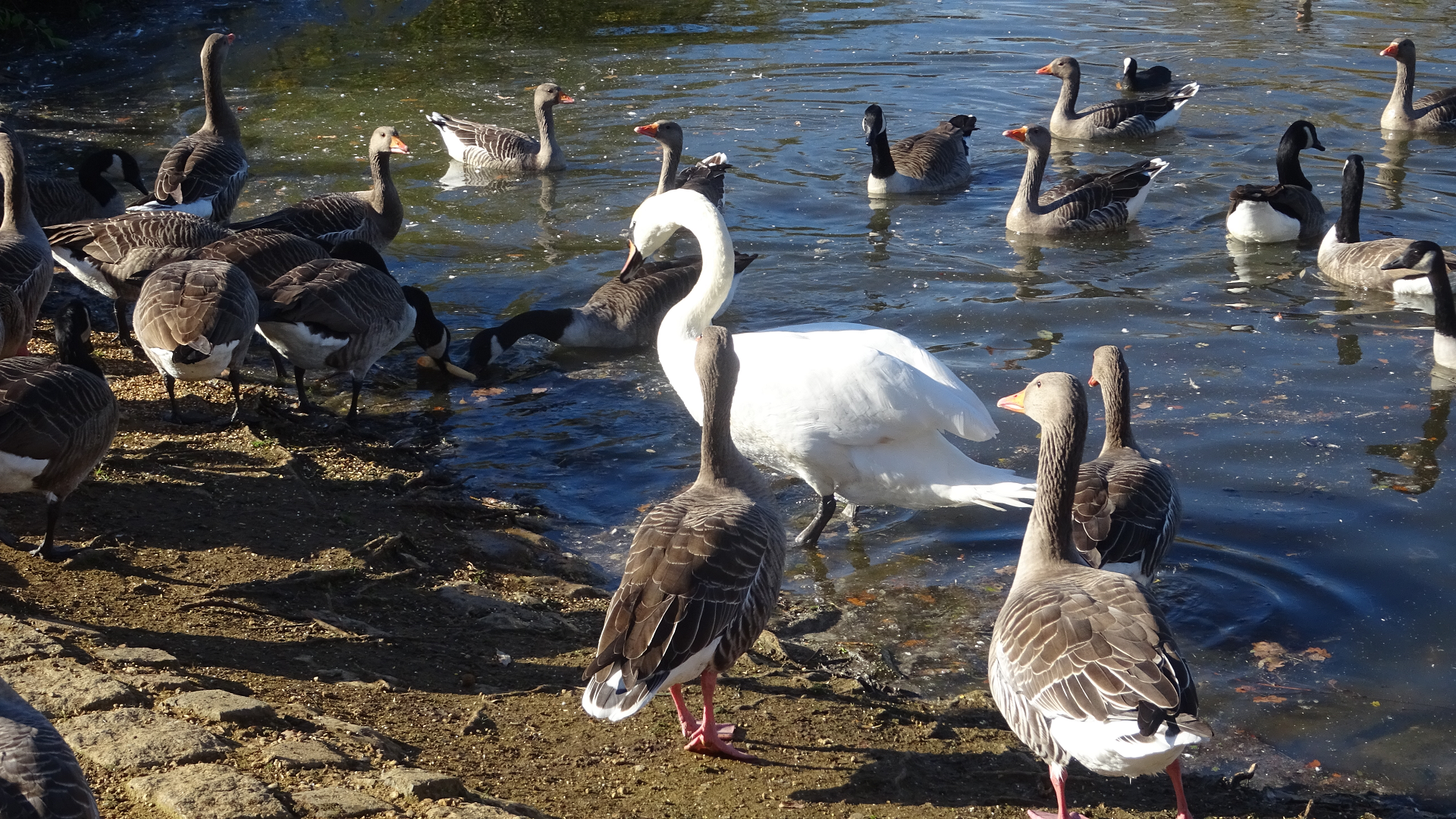
© Raymond Small TQ4792 27/10/2024
Thank you to everyone that has contributed this month.
The Journals are now going into hibernation.

